

|
| articles | forbidden stories I-State Lines resources my hidden history reviews | home | ||||||||||||||||||||||||||||||||||||||||||||||||||||||||||||||||||||||||||||||||||||||||||||||||||||||||||||||||||||||||||||||||

Writing/Film Dear Aspiring Writers: The Worst Advice You'll Ever Read A Literary Look at I-State Lines Spirited Away: Decay and Renewal An American Poem (Robinson Jeffers) Taoist Chinese Poems The Nelson Touch "It's all about oil, isn't it?" Kurosawa's High and Low A Bountiful Mutiny Howl's Moving Castle Thailand's Iron Ladies Trois Colours: Red The Thin Man: Thoroughly Modern Movies Why My Book Is Better Than the DaVinci Code Iranian Films: The Mirror Piratical Nonsense A Real Pirate Movie: Captain Blood 2005-06 archives 2007 archives Recommended Books American Identity American Identity Literary Contest Winners, 2006 (fiction and essays) Hapas: The New America Can You Tell What I am? Part I Can You Tell What I am? Part II Only in America Self-Reliance Your Tattoo in 50 Years The American House and Frank Lloyd Wright Cultural Commentaries On Hatred and Anti-Americanism Anti-Americanism Part 2 Anti-Americanism Part 3 French-Bashing Germany: We All Have Problems, But... Kroika! Chronicles This Blog Sells Out Doom and Gloom Sells The Kroika Mascot-"Auspicious Pet" Wal-Mart and Kroika Kroika and Starsbuck Take a Hit Kroika Ad 1 Kroika Ad 2 Kroika Ad 3 Kroika Ad 4 Kroika Makes Bid for Oreo (April 1) Unfolding Crises: Asia China: An Interim Report Shanghai Postcard 2004 Corruption and Avian Flu: China's Dynamic Duo Exporting the Real Estate Bubble to China Is the Bloom Off the China Rose? China Irony: Steel, Marx & Capital Curing The U.S. and China's Dysfunctional Relationship China and U.S. Inflation Trade with China: Making Out Like a Bandit Whither China? Will the Housing Bust Take Down China? China's Dependence on Exports to U.S.; Is China About to Pop? 2005-06 archives 2007 archives Battle for the Soul of America Katrina, Vietnam, Iraq: National Purpose, National Sacrifice Is This a Nation at War? A Nation in Denial Why Is This Such a Tepid Time? That Price Isn't Cheap, It's Subsidized The Most Hated Company in America U.S. Fascists Seek Ban on Cancer Vaccine The Truth About Christmas American Dream or American Nightmare? 2006 Sea Change Obesity and Debt Immigration Ironies U.S. Healthcare: Working Toward a Real Solution A Drug Industry Running Amok Where There Is Ruin 2005-06 archives 2007 archives Financial Meltdown Watch What This Country Needs Is a... Good Recession Are We Entering the Next Age of Turmoil? Why Inflation Appears Low Doubling Down on 5-Card No-See-Um A Rickety Global House of Cards Are Japan and Germany Truly on the Mend? Unprecedented Risk 2 Could One Rogue Trader Bring Down the Market? Worried about Inflation? Stop Measuring It Economy Great? Bah, Humbug Huge Deficits and Huge Profits: Coincidence? Who's The Largest Exporter? Three Snapshots of the U.S. Economy Loaded for Bear Comparing Nasdaq to Depression-Era Dow Who's Buying Treasury Bonds? And Why? Derivatives: Wall Street Fiddles, Rome Smolders Financial Chickens Coming Home to Roost Is the Stock Market on the Same Planet as the Economy? The Housing-Recession-Oil-Healthcare Connection Could We Have Deflation and Inflation At the Same Time? What We Know, What We Can Safely Predict Bankruptcy U.S.A.: Medicare, Greed and Collapse Sucker's Rally A Whiff of Apocalypse Where There Is Ruin II: Social Security 2005-06 archives 2007 archives Planetary Meltdown Watch The Immensity of Global Warming Sun Sets on Skeptics of Global Warming Housing Bubble Watch Charting Unaffordability A Monster of a Housing Bubble A Coup de Grace to the Economy Hidden Costs of the Housing Bubble Housing Bubble? What Bubble? Housing Bubble II Housing Bubble III: Pop! Housing Market Slips Toward Cliff Housing Market Demographics Housing: Catching the Falling Knife Five Stages of the Housing Bubble Derailing the Property Tax Gravy Train Bubbling Property Taxes Have You Checked Your Property Taxes Recently? Housing Bubble: Where's the Bottom? Housing Bubble: Bottom II The Housing - Inflation Connection The Coming Foreclosure Nightmare 1 How Many Foreclosures Will Hit the Market? Housing Wealth Effect Shifts Into Reverse Housing Bubble Bust Will Take Down the Global Economy The New Road to Serfdom: A Negative-Equity Mortgage The Housing-Savings-Recession Connection After the Bubble: How Low Will It Go? After the Bubble: Rents and Housing Values Why Post-Bubble Rents Matter After the Bubble: How Low Will We Go, Part II Housing: 10% Decline May Trigger Financial Ruin How to Buy a $450K Home for $750K Inflation and Housing: Calculating the Bust The Growing Financial Risks of the Housing Bubble Construction Defects: The Flood to Come? Construction Defects Part II Who Gets Hammered in the 2007 Housing Bust Real Estate Bust: The Exhaustion of Debt What Happens When Housing Employment Plummets? One More Hole in the Housing Bubble: Insurance Financial Kryptonite in a "Super-Strength" Housing Market Three Secrets to Unloading Property Today Welcome to Fantasyland: Housing's "Soft Landing" Why Is the Median House Price Still Rising? Why Median Prices Appear to be Rising? The Root Cause of the Housing Bubble Housing Dominoes Fall Twilight for Exurbia? Phase Transitions, Symmetry and Post-Bubble Declines Housing's Stairstep Descent 2005-06 archives 2007 archives Oil/Energy Crises Whither Oil? How much Is a Gallon of Gas Worth? The End of Cheap Oil Natural Gas, Naturally High Arab Oil Money and U.S. Treasuries: Quid Pro Quo? The C.I.A., Oil and the Wisdom of Crowds The Flutter of a Butterfly's Wings? A One-Two Punch to a Glass Jaw Running Out Of Oil vs. Running Out of Cheap Oil 2005-06 archives 2007 archives Outside the Box How to Make a Favicon Asian Emoticons In Memoriam: Winky Cosmos The Wheeled Vagabonds Geezer Rock Overload Paying for Web Content Light-As-Air Pancake Recipe In a Humorous Vein If Only Writers Had Uniforms Opening the Kimono Happiness for Sale: Jank Coffee Ten Guaranteed Predictions for 2010 Why My Book Is Better Than the DaVinci Code My Brand Management Stinks Design Follies The New Jank Coffee Shop Jank Coffee, Upscale Tropic Style One-Word Titles Complacency Nostalgia Lifespans Praxis Keys to Affordable Housing U.S. Conservation & China Steve Toma, Me & Skil 77s: 30 years of Labor Real Science in the Bolivian Forest Deforestation and Sustainable Forestry The Solar Economy (book) The Problem with Techno-Fixes I Love Technology, I Hate Technology How To Blow off Web Ads and More 2005-06 archives 2007 archives Health, Wealth & Demographics Beauty of the Augmented (Korean) Kind Demographics and War The Healthiest Cold Cereal: Surprise! 900 Miles to the Gallon Are Our Cities Making Us Fat? One Serving of Deception Is Obesity an Inflammatory Response? Demographics & National Bankruptcy The Decline of Europe: A Demographic Done Deal? Are the Risks of Obesity Overstated? Healthcare: Unaffordable Everywhere Medication Nation The New Disease We Just Know You've Got Can You Can Tell Which Pill Is Fake? Bankruptcy U.S.A.: Medicare, Greed and Collapse The 10 Secrets to Permanent Weight Loss 2005-06 archives 2007 archives Landscapes Selling the Landscape The Downside of Density Building Heights and Arboral Roots Terroir: France & California L.A.: It's About Cheap Oil The Last Redwood Airport Walkabouts Waimea Canyon, Yosemite, Camping & Pancakes Nourishment The French Village Bakery Ideas What Is Happiness? Our Education System: a Factory Metaphor? Understanding Globalization: Braudel Can You Create Creativity? Do Average People Know More Than Their Leaders? On The Impermanence of Work Flattening the Knowledge Curve: The "Googling" Effect Human Bandwidth and Knowledge Iraqi Guangxi Splogs, Blogs and "News" "There is no alternative to being yourself" Is There a Cycle to War? Leisure, Time and Valentines Is the Web a Giant Copy Machine? Science Matters Anti-Missile Defense: Boost Phase Vulnerability History The Strolling Bones: Rock of Ages Bad Karma: Election Fraud 1960 Hiroshima: First Use All the Tea in China, All the Ginseng in America Friday Quiz Pet Obesity The Origins of Carbonara Organic Farms Oil and Renewable Energy Human Diseases Wine and Alzheimers Biggest Consumers of Chocolate 2005-06 archives 2007 archives Essential Books The Misbehavior of Markets Boiling Point (Global Warming) Our Stolen Future: How We Are Threatening Our Fertility, Intelligence and Survival How We Know What Isn't So Fewer: How the New Demography of Depopulation Will Shape Our Future The Coming Generational Storm: What You Need to Know about America's Economic Future The Third Chimpanzee: The Evolution and Future of the Human Animal The Future of Life Beyond Oil: The View from Hubbert's Peak The Party's Over: Oil, War and the Fate of Industrial Societies Twilight in the Desert: The Coming Saudi Oil Shock and the World Economy The Solar Economy: Renewable Energy for a Sustainable Global Future The Dollar Crisis: Causes, Consequences, Cures Running On Empty: How The Democratic and Republican Parties Are Bankrupting Our Future and What Americans Can Do About It Feeling Good: The New Mood Therapy Revised and Updated Recommended Books More book reviews Archives: weblog April 2007 weblog March 2007 weblog February 2007 weblog January 2007 weblog December 2006 weblog November 2006 weblog October 2006 weblog September 2006 weblog August 2006 weblog July 2006 weblog June 2006 weblog May 2006 weblog April 2006 weblog March 2006 weblog February 2006 weblog January 2006 weblog December 2005 weblog November 2005 weblog October 2005 weblog September 2005 weblog August 2005 weblog July 2005 weblog June 2005 weblog May 2005 What's New, 2/03 - 5/05 
|
 |

Lyrics/Poems for Our Age June 30, 2007 Frequent contributor Bill Murath sent in a song recommendation whose lyrics, he suggests, "are so fitting of the time now." Have a read/listen and see if you agree; I certainly do. The percentage you're paying is too high priced While you're living beyond all your means And the man in the suit has just bought a new car From the profit he's made on your dreams But today you just read that the man was shot dead By a gun that didn't make any noise But it wasn't the bullet that laid him to rest was The low spark of high-heeled boys If you had just a minute to breathe and they granted you one final wish Would you ask for something like another chance? Or something similar as this? Don't worry too much It'll happen to you as sure as your sorrows are joys And the thing that disturbs you is only the sound of The low spark of high-heeled boys If I gave you everything that I owned and asked for nothing in return Would you do the same for me as I would for you? Or take me for a ride, and strip me of everything including my pride But spirit is something that no one destroys And the sound that I'm hearing is only the sound The low spark of high-heeled boys The Low Spark of the High-Heeled Boys by Steve Winwood/Jim Capaldi and recorded by Traffic in 1972. My own recommendation is justifiably famous but has never seemed more accurate than in our "house of mirrors and lies/The Emperor has no clothes" era: Turning and turning in the widening gyreShall we hazard a comment and suggest the falconer is our better sense, and the falcon our nation, running out of control on so many levels, loosing a blood-dimmed tide? As for the worst being full of passionate intensity--look no further than your nearest ideologue pounding the podium for the next war, culturally or geopolitically, insulting and deriding any and all opposition with any means at hand (wishing John Edwards had been killed in a terror attack, such a thoughtful, reasonable political comment, the true voice of unmuzzled right-wing purity). As for the ceremony of innocence--a belief that no one is above the law, and that the law is above political meddling--it has indeed been drowned by Executive privilege, the last resort of liars and thieves. Yet the nation dances in the street of "endless prosperity," mindless of everything but what can be purchased, consumed or displayed in a show of self-absorbed pride. As things fall apart--and certainly the center is not holding--perhaps mere anarchy will soon be loosed on our built-on-the-shifting-sands-of-lies world. Science Matters: Global Warming--Read These Two Essays June 29, 2007 I am not a scientist by trade, but I believe most science is accessible to anyone with a high school education and a willingness to learn. For example, the vast majority of the articles in Scientific American are accessible to the layman/laywoman, as that is the intended audience. I say this as someone with only high school chemistry and physics in my formal-education science folder, and as a 25-year subscriber to Scientific American. Science is like medicine: if you don't want to learn anything yourself and you just want to trust "the experts," prepare to make some very bad choices. Like agreeing to a needless or risky operation and promptly dying, if not on the operating table, then of an infection you picked up in the hospital. Or taking an ineffectual drug and erroneously thinking you're being "cured." Frequent contributor U. Doran recommended a fascinating dismantling of Big Pharma's (the big drug makers) statistical legerdemaine (slight of hand) The crucial health stat you've never heard of. The article describes how drug companies tout a "relative risk reduction" of 31%, which sounds impressive, but in reality the "absolute risk reduction" is only 2%--meaning, only 2 out of 100 people are going to see any results of the "wonder drug." Not as impressive sounding, right? If you look into the Phase 2 and 3 drug trial data which is used to approve drugs, you will find multiple layers of obfuscation and data-finagling. In other words, flaky data is used to get a drug approved, and flaky statistics are used to sell an ignorant public on the supposed benefits of the (expensive, immensely profitable) drug. Speaking of finagled data: here are two of the best, most clearly presented essays on Global Warming you'll ever find, and they are exclusively here at Of Two Minds. We've all read about global warming, and here we have two articles which explain the basis (data) for the global warming thesis, and how it all stacks up. You really owe it to yourself to read these this weekend. Global Warming: Our Story So Far by Michael Goodfellow The Hockey Stick Breaks (Global Warming Data refuted) by Protagoras I think we as a society have absorbed the negative view that science is "too hard to understand," which makes for a handy excuse to "trust the experts." Yes, at very high levels, say, senior-college level classes, then chemistry, biology and physics are technically challenging because you need a large foundation of knowledge to understand "state of the art." But as Scientific American and other science magazines show, even the highest-level science can always be explained in a way that virtually anyone can understand should they desire to do so. As someone who is blessed to count working scientists as longtime friends, I have learned that data collection is the name of the game; if you don't have good data, i.e. data which hasn't been tainted, and which can be repeated in other labs or locales, then you have nothing. Here is an excerpt from Protagoras's look at the validity of the data being used to support the "humans are causing Global Warming" thesis: A truly dramatic event in contemporary intellectual history occurred unnoticed in April. To understand it, you have to understand the history of the famous Hockey Stick climate chart, which has decorated IPCC documents since the late nineties, appeared in lots of Green publications all over the world, and has been used as vivid proof that human caused global warming (AGW) is real and an imminent threat to human life and civilization.And here is an excerpt from Michael Goodfellow's summary of the evidence pro and con for the "humans are causing Global Warming" thesis: Like it or not, real or not, global warming is a huge problem for the world. Serious debate is going on about what to do, government action on this is already affecting us all, and will continue to do so. The potential effects of legislation on the world economy, the politics of trade and on our lifestyles are all huge. So it makes sense to follow this debate as closely as you follow any other big issue, from the housing bubble to the Iraq war. The problem, as usual, is getting some context and separating the facts from the political bias.Both essays provide numerous links to other sources, so you can explore the topic further with just a few clicks. I am deeply indebted to these writers for investing so much energy and time to bring a clear-eyed, well-reasoned perspective to the most important topic of our era. Please take advantage of this opportunity and read these two wonderfully written, well-researched essays. Thank you Roger H. ($20) for your generous donation to this humble site. I am greatly honored by your encouragement, and your readership. All contributors are listed below in acknowledgement of my gratitude. China's Brand and the Product Liability Lawsuits to Come June 28, 2007 Correspondent Cheryl A. recently alerted me to an issue which may well affect China-U.S. trade: defective products and tainted food. here are two links to the Wall Street Journal (subscription required), but the stories are available from many other sources. Accident Raises Safety Concerns On Chinese Tires China Shuts 180 Food Plants Amid Food-Safety Concerns The two big questions are: Is this merely an anomaly, or the tip of an iceberg of defective, dangerous products? and, Can China fix its quality control problems, or are they endemic to its political/economic structure? The Chinese government's first response was to impound some dried fruit from the U.S. and proclaim it dangerously tainted. In other words, "See, you make tainted products, too! So lay off already!" This face-saving gesture went over like a lead balloon, so their next step was to shut a few dozen plants (out of tens of thousands) for a few days. This is the public-relations equivalent of a bulldozer crushing a few thousand pirated DVDs while the cameras roll. Meanwhile a few kilometers away the piraters are making new copies by the millions. Given the vast quantities of foodstuffs such as farmed seafood now being imported from China, the possibility exists that the next tainted-food deaths will not be pets but humans. As various news agencies have reported, humans in other countries have died from consuming Chinese-made drugs which were adulterated with cheap (and poisonous) fillers. As for seafood, consider this recent article from the San Francisco Chronicle: Domestic farmed fish go under the microscope: "Most of (the seafood) we eat that's farmed is coming from China. We have little idea of what's happening in China," said Peet. Food and Water Watch reports that the United States imports 80 percent of the seafood we consume, most of it from Latin America and Asia. The aquaculture practices in many of these countries damage the environment, and many enterprises use additives and antibiotics banned in the United States.Are you still willing to put a Chinese-made tire on your car or truck? I didn't think so. How about when you read about somebody getting sick from some imported seafood which happened to be grown in China? Will you start asking where that jumbo shrimp came from? China has no lock on unregulated industries, of course; there's no way to know what might be in the food which is imported into this country because inspections and testing are virtually non-existent. Exactly how are you going to insure the quality of every jumbo shrimp and tomato? It boils down to trust. In this sense, every nation is a "brand." Back in 1965, Japanese products consisted of cheap toys and transistor radios which were widely mocked as "cheap" and poor in quality. Fifteen years later, the Japanese were challenging American and European auto manufacturers with vehicles a leap ahead in quality and durability. (The Volkswagen Beetle's demise can be correlated to the emergence of the Toyota Corolla and Datsun cars.) It's been fifteen years since China emerged as a manufacturing power, and what they're producing is defective tires, bikes, etc. Various financial pundits with no knowledge of China are fond of saying it will follow the same path to fanatic quality control trod by the Japanese and Koreans (why? Because they're Asians), but this thesis doesn't take into account the following conditions in China which were not present in Japan or Korea: 1. China is deeply and pervasively corrupt at all levels. If you deny this, you simply don't know any Chinese citizens well enough to hear the truth. Your kid doesn't do well on an entrance exam? Some "help" can be arranged. Your factory is dumping toxic pollutants into the air? You can "arrange" to close for a few days and then start running it at night, when the toxic plume isn't visible. The stories are as varied as they are endless. Thus the idea that the quality of anything can be regulated by a trustworthy, uncorruptible agency within China is simply impractical. 2. The dynamism of the economy and its entrepreneurs makes quality control difficult. Entrepreneurs in China often change businesses and locales quickly; thus a fish farm which is closed for over-using antibiotics will close and the owner will enter another business. The bike manufacturer will close if the market dries up and start making something else. While this dynamism is great for employment and growth, it makes external quality control basically impossible. The global corporations can of course control quality in their own factories, but much of the industry in China is localized production of parts and goods made by small businesses. Where did that tainted pet food come from? It took a major investigation of the convoluted, poorly documented supply chain to find out. 3. Quality is not Job One. Those of you who have a religious faith for the "endless growth of China" story will balk, but again, you need to talk to actual real live people, Big Noses (Caucasians) and Chinese, about actual business practices in China. Sure, if you tour a computer parts factory owned and operated by Taiwanese (yes, I have), it all looks great. If you work for a global corporation in a clean little cubicle and frequent watering holes in fancy Shanghai hotels, it probably all looks great to you, too. But what about the silk suit manufacturer down the road, who sold the French guy based on a high-quality silk product and then delivered 50,000 lower-quality suits? Or the pharmaceutical plant which closed over in the business park because their product packaging was quickly pirated and filled with sugar pills, thus destroying the brand? These are real stories, and they're not from 15 years ago. 4. The idea that U.S. agencies can monitor, document and test for quality is a non-starter. Which of the thousands of containers coming from overseas are you going to inspect? How many bottles of medications are you going to laboriously test to make sure it actually contains what the label says it should? It's impossible. It comes down to trust. At some point, let's be original and call it a tipping point, a country's "brand" will fall into distrust. And as any company knows, once the public has lost trust in your brand, it is very difficult to get it back. Could China's "brand" become irrevocably tarnished? It may depend on how many lawsuits get filed and how much publicity is generated--for instance, Wal-Mart prevails in suit over defective bikes made in China. It's no surprise that Wal-Mart would win; they'll probably always win. But if enough suits get filed, they may lose anyway--by losing their customers. I asked fellow blogger and attorney Fred Roper for his take on product liability, and his comments are insightful: My knowledge regarding products liability cases is pretty limited. The rule is: if a merchant sells a product to a user or consumer that is unreasonably dangerous and causes harm then that merchant is liable for the injuries to that user or consumer. Because of the nature of the distribution chain, a plaintiff and sue anyone or everyone in the chain of distribution. The reason for this is that the merchant is presumed to be in a better position to know the potential dangers that the product poses for an unsuspecting consumer. Therefore, the defense of "comparative" or "contributory negligence" is not normally available to defendants in these kinds of cases.Okay, so actually proving negligence on the part of Chinese manufacturers or U.S. distributors and retailers is going to be near-impossible. But the publicity generated by these cases may slowly cause American consumers to start asking where this tire or bicycle was made, and ask where this jumbo shrimp was grown. If they start making decisions based on where these products came from, trade between the U.S. and China could take a direction few expect. Thank you James D. ($25, third donation) for your generous and encouraging donation. I am greatly honored by your continuing support of this humble site. All contributors are listed below in acknowledgement of my gratitude. Does Short Interest Really Support the Market? June 27, 2007 To those of you who tire of financial and stock analysis--my apologies. The reason why I am concentrating on this topic this week is the market may be poised to move dramatically-- which provides an opportunity for us small-fry to profit, should we guess the direction of the move, or hedge our bets properly. Disclosure: I took a short position via puts yesterday in CFC and FNM, two stocks I discussed in the Monday entry. I anticipate them skyrocketing, now that I am short. One reason to suspect the market is posed to move dramatically is all the major indices are hugging their 50-day moving averages; this suggests indecision. The high volume on major down days like last Friday suggests weakness/distribution, i.e. "smart money" selling to those willing to "buy on the dips." Let's consider one cliche you read again and again: record short interest places a strong bid under the market, providing key support in the event of a sharp decline. As this chart shows, this works at the first test of support; but once the shorts have covered, there's no longer any floor under the stock. 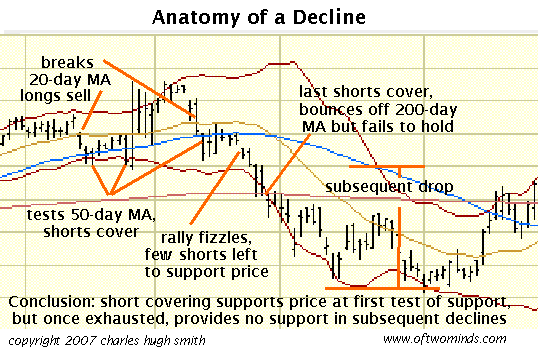
Here's the basic idea: let's say a hedge fund manager owns a million shares of Google; he or she is thus "long" Google. To protect the long position against a sudden drop, the manager sells a million shares short, or buys put option contracts on a million shares. This "short position" fully hedges the million "long" shares against losses. So if GOOG drops $10 per share, the portfolio drops $10 in value on the long side, but gains $10 on the short side--i.e. the shares held short have a $10 gain, as do the puts. Recall that selling short means you received the current price for shares you don't yet own; when you buy the shares later (hopefully for a price lower than you received), then you've "covered your short." The difference between what you sold them for and what you paid to buy them is your profit. Headlines blare that "short interest is at new highs." So guess what percentage of NYSE (New York Stock Exchange) shares are short. Drumroll, please: 3.3%. Yes, the "record high" short interest is not even 4% of all outstanding shares--about 12 billion shares, or four days' trading volume. This is an awfully small percentage of shares to support the idea the market can't decline very much. Let's stand in the shoes of the hedge manager for a moment. Let's say you sense GOOG is weakening--say it's dropped below the key technical level of the 20-day moving average. Why would you hold your long shares if you detected a downtrend in the making? You'd sell (distribute) your long shares, and hold your short shares or puts until the dust settles. Guess what: every other manager with a long position is thinking the same way. So as everyone dumps their long shares, the selling accelerates the price decline. At some point--again, perhaps the 50-day or 200-day moving average, some managers will "cover their shorts" by buying shares of GOOG. This does provide a temporary "floor" under a stock's decline--but what happens when the shorts have all covered and the price is still dropping? There is no longer any shorts to provide a bid/buying. As this chart (the stock is CFC) shows, once key technical levels which trigger short covering are violated, then the stock continues dropping. You may recall reading contributor Harun I.'s comments on the Pareto Principle in Hedge Funds and The Pareto Principle (February 19, 2007). The principle is often called the 80/20 rule, and it has an adjunct: the 64/4 rule. Hmm, isn't it interesting that short positions are about 4% of the market. The principle suggests that small number of shares can have an effect far larger than their percentage would suggest, causing major shifts in 64% of all shares. Proponents of the "short covering will support the market" idea are convinced the 4% covering will support the 64% of stocks declining; they may be right for awhile, but when the 4% have covered, the effect might be to remove the last leg of support from a market which then goes into a free-fall. Why is short interest rising? There may be two reasons. One is the growth of hedge funds, which hedge long positions by going short. (Many mutual funds are restricted from having large short positions.) The other might be that those who tend to go short--i.e. professional managers and traders--are making sure they will profit should a sharp downtrend occur. To summarize: take all assurances that "record shorts will support the market" with a hefty grain of salt/skepticism. Hedge funds may unwind both long and short positions in a hurry, further draining the pool of shorts which need to be covered. Thank you John G. ($26.26) for your generous and interestingly numerated donation. I am greatly honored by your support of this humble site. All contributors are listed below in acknowledgement of my gratitude. If you found value here perhaps you'd like to Your readership is greatly appreciated with or without a donation. The 9 Biggest Mistakes Investors Make June 26, 2007 NOTE: Readers Journal and essays have been updated. A certain investment service has been buying full-page ads in major U.S. newspapers touting their free report, The 8 Biggest Mistakes Investors Make. Ha, I sneer at their mere 8, and handily trump them by offering The 9 Biggest Mistakes Investors Make. 1. Investors purchase stocks, bonds or real estate in the months of January, February, March, April, May or June. 2. Investors purchase stocks, bonds or real estate in the months of July, August, September, October, November, or (horrors) December. 3. Investors base their decisions on investment newsletters hyped in full-page ads or on the "financial" TV channels rather than on their own analysis. 4. Investors rely on "hot tips" from blogs and websites rather than sweat through their own analysis. (Yes, blogs like this one) 5. Investors confuse goateed raving lunatics providing free entertainment in the form of "investment advice" on TV with trustworthy expertise. 6. Investors buy Kraft Foods (ticker KFT) because they like Cheez-Whiz, e.g. "buy what they know." 7. Investors obsess over high-falutin' math (standard deviations, etc.) and obtuse technical signals (The Titanic Signal, etc.) while ignoring the most basic formula of investing: Hope + Greed + Ignorance + Fear = Losses. 8. Investors focus on the "buy" button but forget to hit the "sell" button until it's too late. 9. Investors actually give credence to investment banks and buy-side analysts' recommendations--for instance, the recommendation yesterday to "buy General Motors." Now this must be right, because it comes from Goldman Sachs, right? Goldman Sachs analyst Robert Barry upgraded General Motors (GM) to buy from neutral in what he described as a "tactical trading call." He also raised his price target on the shares to $42 from $29. GM's stock price "implies little to no downside and potentially large upside from the real possibility concessions end up even larger than what is priced in," he said in a note to clients.Count me skeptical, but even though this analyst from the fine firm which provided us our current Treasury Secretary says there is "little to no downside" in GM, let's look at a simple chart: 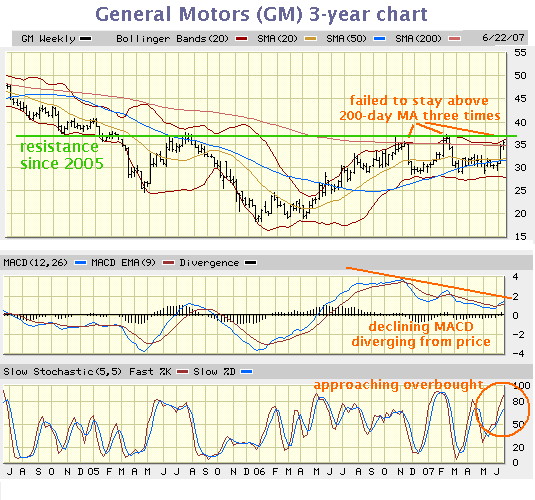
"Little to no downside"? I guess a drop from $37 to $20 doesn't count? A target of $42, when $37 has been ironclad resistance since early 2005? What alternative Universe does this analyst think GM inhabits? Never mind that a purely technical view suggests this stock is a beautiful short (i.e. primed to drop significantly)--take a gander at the MACD divergence, if you will--what about the fundamentals of the company's business? Is the consumer in fine fettle and raring to take on even more auto loan debt? Does GM have a profitable small-car line as gasoline retrenches at $3/gallon on its way to $4/gallon? Do they manufacture a hybrid lines of vehicles to compete with Toyota and Honda? Is there any published analysis which proves modest "concessions" from the UAW will transform an essentially bankrupt corporation (its pension and retiree healthcare liabilities far exceed its assets) into a viable firm? Allow me to sumamrize: there is absolutely no technical reason to believe GM is heading to $42, and much evidence it's heading to $20, if not $ .20. There is absolutely no evidence that GM is not a technically bankrupt company heading for formal bankrupty in the next recession (scheduled to begin in October 2007). Yet here we have "reputable analysts" from "reputable firms" (gag!) telling suckers, I mean "retail investors," to gamble their hard-earned money on a high-risk bet. Why? Probably so Goldman Sachs and its big clients can distribute/dump/unload their doomed shares of GM onto poor suckers naive enough to believe their "recommendation" isn't purely self-serving. Is there no shame? None whatsoever. Caveat emptor, Baby. Let the buyer beware. NOTE: At the time of posting this entry, I did not have any position in GM. However, I did profitably buy puts on the stock the last time it hit $36. That is disclosure, not advice. EXTRA SPECIAL BONUS NOTE: "The Titanic Signal" is a fabrication/satire. It is my invention. Oh, and by the way, it's flashing a huge gleaming red "sell". Thank you Cheryl A. ($25.00, third donation) for your generous and quite unexpected donation. I am greatly honored by your continuing support of this humble site. All contributors are listed below in acknowledgement of my gratitude. Profiting from the Housing Bubble Popping June 25, 2007 Is there some way to profit from the deflating housing bubble? Perhaps. Let's get one thing straight: the following is not investment advice. It is merely a series of "if-then" statements with which you may or may not agree. IF you believe that the real estate industry is losing steam/trending downward/dropping in value, THEN note that the Ultra-Short Real Estate ETF (exchange-traded fund) rises 2% for every 1% drop in the ETF's constituent stocks--hence the descriptor "ultra-short." ETFs trade like stocks. Here is a chart of the fund, which only started this year; note that it rises in value as the ETF drops in value. 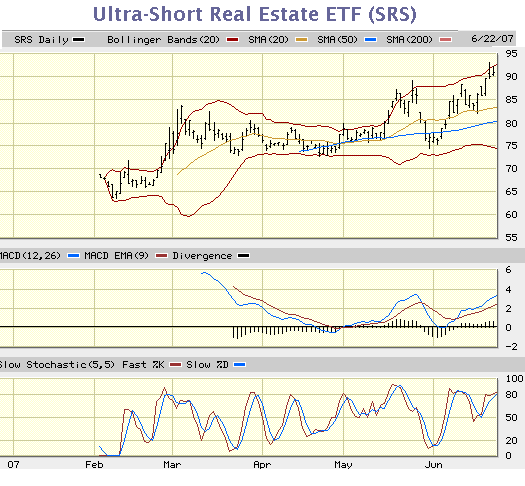
IF you believe that Fannie Mae, the quasi-government mortgage outfit, holds a lot more risky mortgages and debt than Wall Street reckons, THEN note the negative indicators on this chart which support the notion that this stock is about to drop through its 20-day moving average support: 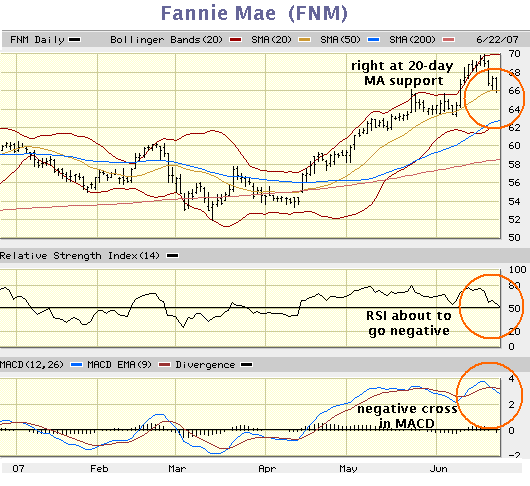
IF you believe that the entire banking/lending sector holds a lot more at-risk debt than Wall Street reckons, THEN note the negative indicators on this chart; this ETF has dropped below the critical 200-day moving average support: 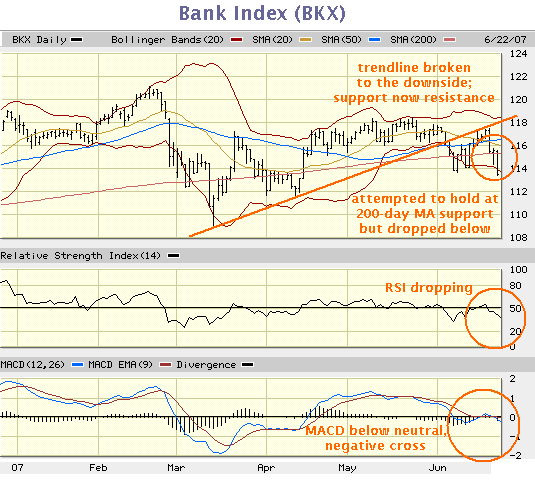
IF you believe that lenders such as Countrywide Finance Corp. hold substantially more at-risk (subprime, ALT-A, ARM) mortgages than Wall Street reckons, THEN note the negative indicators on this chart; this stock has dropped below the critical 200-day moving average support: 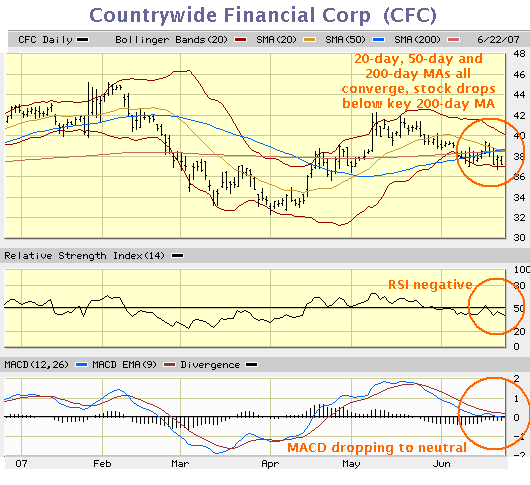
IF you believe that a stock/ETF will drop in price, and you want to gain from that drop, THEN you either sell the stock/ETF short or purchase put options on that stock/ETF. IF you aren't familiar with these terms, THEN please do some Web searches to find out more. TO REPEAT (sorry for shouting): none of the above, or anything on this site, is investment advice. It is a series of if-then statements with which you are free to disagree, ponder, ignore, explore, etc. NOTE: at the time of this posting, I have no position in any of the securities mentioned above. If you found value here at "an ad-free, rigorously civil exchange of ideas and knowledge," perhaps you'd like to Your readership is greatly appreciated with or without a donation. This Week's Theme: Context On-The-Ground Reporting in China June 23, 2007  Longtime correspondent Martin recently recommended an article on China
The Empire of Lies by French free-lance journalist Guy Sorman.
Longtime correspondent Martin recently recommended an article on China
The Empire of Lies by French free-lance journalist Guy Sorman.
What separates Sorman's report from the typical China story is his on-the-ground journalism with people and places rarely visited by Western media types. In case you didn't know, the Chinese government employs a vast army of people to manage/spin news, not just for its own citizens ("The Great Firewall of China" to censor the Web) but for the outside world as well. It takes some real digging to get past the bogus government statistics, cover-ups and lies. Sorman does a fine job, one which can't be denied or dismissed by cheerleaders. Here's a taste of his reporting: It had taken me several months and many intermediaries before I could finally meet with this self-effacing, frail 75-year-old, branded an enemy of China by the Party—a label it gives to anyone with the temerity to oppose the regime.Here is his report on the central government's response to AIDS: The government’s initial reaction was to deny any problem, isolate AIDS-affected areas, and let the sick die (a pattern that initially repeated itself when SARS broke out in the country).To extend our theme of Context with a Capital C, let's consider how little understanding of Chinese culture goes into the standard U.S. financial analysis. To take but one example, financial analyst John Mauldin is recommending a book by PIMCO (bond fund) manager Paul McCulley and veteran reporter Jonathon Fuerbringer, Your Financial Edge. From Mr. Mauldin's review, the book seems to have much good analysis of big issues; but the authors' lack of understanding of Chinese culture is striking. Here is a quote: "Ultimately, though, China will switch from a mass production economy to a mass production and mass consumption economy and have the courage and ability to free its exchange rate and shift away from its mercantilist model."I wonder if either of the writers actually knows any mainland Chinese people. Why do I wonder? Because every one of our many Chinese friends has paid off their house mortgage within a few years of its purchase. This is true regardless of which city they came from in China (central, coast, Nanjing, etc.) and regardless of their salaries: those with substantial incomes bought more expensive houses, and those with more modest salaries bought less expensive houses. How many non-Chinese Americans do you know who pay off their mortgage in 5 years? Again, these are not big-bucks doctors and lawyers or people who inherited wealth or trust funds; these are average folks with median incomes. Do you know how they achieved this monumental goal? Scrimp and save. Minimum consumption. No frills lifestyle. And once the mortgage is paid off, do they then begin spending lavishly? No, they buy another property or add on to their house--paid in cash. 
If you examine the lifestyles of everyone beyond the few million Shanghai-Beijing-yuppies, you will find a nation, and more importantly, a culture, of prodigious savers. If you know anything about Chinese culture or if you know even a few dozen mainland Chinese people well, you know China will not transition to a culture of consumption in this generation. A very good anthropological case could be made that China will never leap from a culture of savers and investors to one of borrowing and consumption. Not in five years, 20 years or even 100 years. Economies may change quickly, but cultures do not. Yes, Proctor and Gamble is selling Crest toothpaste to residents of small villages in western China. Chinese people will buy TVs, meat, seafood, and a variety of other consumer goods. But to claim that China's culture and economy will seamlessly transform from a mercantilist export-driven model to a consumerist clone of the U.S.--based on what evidence? A few million free-spending yuppies out of a nation of 1.2 billion? If you think that's a sound footing for an analysis of an enormous nation, then do you base your prognostications for the U.S. on the top-income residents of Manhattan? If so, your analysis will be fatally flawed. Yet financial writers continue to accept the most breathless extrapolations for Chinese consumption based on the spending of an equivalent handful of rich, top-of-the-heap free-spenders who can be seen in hotel bars and fancy restaurants in Shanghai and Beijing--the kind financial journalists apparently base their "research" on. If you haven't read my own attempt at providing a broad context for China's economy, here it is: China: An Interim Report. For more on Chinese patterns of consumption and saving, please read the June 5 entry, Can the U.S. Go Down and China Stay Up? Thank you Matthew N ($10.00) for your generous and quite unexpected donation. I am greatly honored by your support of this humble site. All contributors are listed below in acknowledgement of my gratitude. This Week's Theme: Context Little Miss Sunshine and American Optimism June 22, 2007 Is the incredibly wicked satire of last year's independent film hit Little Miss Sunshine Do other cultures breed a hyper-competitive drive for "number one" rankings in everything from piloting USAF jets to talent contests to wealth and recognition on the motivational circuit to academic studies of Proust? Do other cultures quickly label everyone who competes but doesn't win "a loser"? Do other cultures heap such lopsided praise on "winners" and offer so little to the "rest of us" that suicide (at least in this film) seems like a better alternative than slipping in the rankings? I honestly don't know, but I suspect not. In the event other cultures may be mystified by the dark humor and rapier-like parody in this film, I offer up the following as context for understanding this justifiably popular movie. I am not immune to competitive juices, so I say this not as a smarmy putdown of competition but to draw the distinction between the honor implicit in competing and the pathological emphasis now placed on "winning" "the top spot" in American society. I played on basketball teams for five years in junior and high school and a year of football in 10th grade (hard-working talentless benchwarmer, but hey, I had fun being part of the teams), and I was a contractor/carpenter in the deep recession of the early 80s. You want a "Darwinian fight to the death?" That was the "interest rate is 16%, nobody's building anything" reality then. And if you want a competition where winning is literally one shot in a million--try writing. 30 million blogs (or is it 300 million?), 5,000 novels published each year, 100,000 books in print, blah blah blah. The point is: has our society veered into a pathology of winning, in which parents are punching Little League coaches and screaming at little kids for not scoring more than their opponents? This film says yes, definitely, categorically, yes. Critics generally describe this as a comedy about a dysfunctional family. It isn't that at all; it's a biting critique of a dysfunctional society. The family is actually the only source of support and solace available to the beleagered individuals depicted in the film as they each strive--and painfully fail to reach--the pinnacle of the American Dream: success through hard work and meritocracy. The banality of this goal is ruthlessly satirized as the movie progresses. Every conceivable form of American Success with a Capital S is savagely revealed as distorting and empty. The daughter's painfully bawdy routine--a searing exaggeration of the contest's subtext of pushing adulthood onto little girls--draws predictable howls of outrage from the contest authorities, and rallies the family to her side. Though other bits of American life get similarly skewered, the key satire is of The American Dream: wealth and recognition achieved via hard work and "pursuing your dreams." As the wheels fall off the U.S. and global economies, I have to wonder how Americans will adapt to the narrowing of opportunities and the ever-tightening strictures of debt and job losses. I wonder if they will begin to understand the myths they bought into and clung to so tenaciously as their plight deepened, ("the Ownership Society funded by leveraged debt", for instance) and realise that if they bothered to vote (recall that U.S. voter turnout is a miserable 40% compared to 80% in France and other well-established democracies), they might regain the political power which they have so passively ceded in their individual obsession with competitive triumph and public recognition. Thank you Jaimi A. ($10.00) for your generous and entirely unexpected donation from the country so many Europeans would like to retire to. I am greatly honored by your international support of my humble efforts. All contributors are listed below in acknowledgement of my gratitude. My sincere thank you to all 124 readers who have contributed money, art, music and food in the 3 months since I began accepting donations to this humble site. This Week's Theme: Context Sword of Doom June 21, 2007 Normally you could safely assume an entry entitled "Sword of Doom" refers to some financial meltdown, but today we refer to a classic samurai film. This week's theme of context requires at least one cultural entry, for there are few more dangerous minefields than context-free cultural misunderstandings. "Why can't they be more like us?" A universal plea, to be sure. Since movies can offer an uncannily accurate window into a culture, let's consider a 1966 Japanese classic of the samurai genre, The Sword of Doom 
As those of you familiar with the genre might expect, Sword of Doom depicts tremendous violence. Most of the swordplay is highly stylized, but if seeing 20+ swordsmen cut down is not your cup of tea, you might decide to pass on the film. In a way, that would be a shame, for this film speaks not just to Japanese culture and history, but to universal themes of evil and revenge. The movie stars the incomparable Tatsuya Nakadai as a heartless--some might even say sociopathic-- samurai who has mastered a non-standard, unorthodox style of kendo or fencing. Perhaps it is his unorthodox style, or his ruthlessness, or both, but he has been kicked out of his kendo school. This establishes him as a ronin, or masterless samurai--in our nomenclature, a lone wolf. The movie is set in a time of social dissolution and turmoil, the early 1860s, when the feudal order which had held sway over Japan for over 200 years was breaking apart. The Meiji Restoration of 1868 restored social order by dissolving the Shogunate in favor of the Imperial household. (In practical terms, a ruling-class oligarchy was established.) Thus later in the film, Nakadai's mistress bemoans his lack of standing, commenting that in earlier time, he would have had his own kendo school and they could have lived comfortably. Instead, Nakadai is forced to hire himself out as a political assassin for a pittance; he consoles himself by drinking prodigious quantities of sake (rice wine). Early on, Nakadai dispatches an unarmed elderly man and shortly thereafter, an opponent in what was supposed to be a non-lethal match. (In exchange for her favors, he'd secretly agreed with his opponent's wife to throw the match. Alas, the cuckolded husband tried to dispatch him, forcing Nakadai to kill him.) These unsavory scenes establish Nakadai as ruthless, amoral and maddeningly difficult to kill. Nonetheless, the outlines of his own unorthodox code of conduct are visible. The elderly man had been praying to be released from this life; overhearing the gent's plea to Buddha, Nakadai took it upon himself to grant the man's stated wish via his sword. And Nakadai held to his bargain with the other samurai's wife, allowing the match to be a draw, until his opponent tried to kill him with an illegal move. But there is a karmic consequence of these needless killings, and a subplot of revenge is set in motion, building our anticipation of a classic showdown in the final reel. But our expectations are foiled. I won't give away the ending, except to say it is not the one-on-one "good guy versus bad guy" showdown we are led to expect, but a harrowing melee in a burning Japanese house in which Nakadai takes on the entire clan who'd engaged him as a sword-for-hire. Online sources say this "unsatisfying" ending results from the film originally being planned as the first of a trilogy. I respectfully submit that the filmaker designed this movie to stand on its own, and deliberately chose a very 1960s "anti-expectation" ending. This final climatic sword battle--truly one of the great action sequences of world film, in my humble view--is unleashed by a betrayal (the clan tries to kill Nakadai) and a ghostly visit by Nakadai's victims, who haunt him to the edge of madness. One online reviewer scoffed at this haunting (shall we also then dismiss Shakespeare's Hamlet?), but ghosts (obake, spirits, etc.), animism and various superstitions are key elements of Japanese culture. That Nakadai's descent into madness begins with a haunting is essentially Japanese. Those of you who are Japanese or who have lived in Japan for years may disagree, but I see this film as a critique of the Japanese reverence for mastery--an unplanned, subconscious critique or a conscious one, I can't say. Acting legend Toshiro Mifune plays the master of another kendo school, and in a meeting with Nakadai he proclaims that "The sword is the soul. Study the soul to know the sword. Evil mind, evil sword." For his part, the Nakadai character exclaims, "I trust only my sword in this world. When I fight, I have no family." That is, he has no loyalty to anyone but himself and his mastery of the sword. Mifune's comment--the sword is the soul--embodies the ideal of mastery; in Japan, masters of craft are revered as Living Masters. Mifune is proclaiming a moral truism: if the heart is evil, so too will be the mastery. But Nakadai's character also expresses an ideal of mastery--that of one unbound from loyalty and obligation to anyone or anything but the mastery itself. Perhaps the theme many Japanese viewers would identify is this: mastery without loyalty and duty is inherently unstable and ultimately dangerous. In American Westerns, such as the 1960s Clint Eastwood films A Fistful of Dollars and For a Few Dollars More (which were based on Kurosawa's samurai classics, Yojimbo and Sanjuro), the anti-hero is a higher-order hero, wreaking a justice which the orthodox lawman could not pursue. In this 1966 Japanese anti-hero classic, the Nakadai character is not a source of justice or righteous vengence, but a "loose cannon" who is dangerous to all around him, an uncontrollable force so evil that his own father wants him killed. Can we view this film in a cultural vacuum, knowing nothing of Japan's history and culture? Of course we can; but without such context, key themes of the movie may well be indiscernible, just as much of Japan will remain hidden to the casual visitor. Critic's Disclosure: I studied Japanese language (and therefore a bit of written Chinese as well, as kanji are Chinese characters), geography, history and literature, as well as Korean poetry and Chinese philosophy at university. I have visited each country for extended periods but remain a mere student of these cultures. Sadly, my limited Japanese language skills have been reduced by time to rubble. Thank you Susan P. ($20.00) for your generous and entirely unexpected donation. I am greatly honored by your support. All contributors are listed below in acknowledgement of my gratitude. This Week's Theme: Context How the Housing Bubble/Credit Bubble Will Pop June 20, 2007 When 2008 rolls around and the U.S. economy is sinking with frightening momentum into a bottomless quagmire, you'll be glad you read this entry. Why? Because you anticipated every step of the implosion and warned your friends who were still floating complacently down that river in Egypt (de-nial). In keeping with our theme of context, let's begin by noting that the proper context for the housing bubble is the all-encompassing global credit bubble which has inflated every asset class. With this fundamental firmly in mind, let's follow Deep Throat's advice from the classic film All the President's Men Let's first dispense with "the real estate market". Yes, supply and demand and housing starts and zillow.com and neighborhood sales and all the other market stuff play a part in the coming implosion, but all that noise is more a sideshow than the Main Event. Why? Follow the money. The main event is the credit market, because if you can't borrow money, or can only borrow it at a premium and under tight conditions, then how many houses are for sale in your neighborhood or the median price paid, etc. shrink to near-meaningless. Real estate sales and valuations depend solely on credit. Everything else is secondary. Next, let's dispense with the notion that the implosion of housing-based lending can be "quarantined" and won't affect the economy. The reason is that mortgage-backed securities, and the CDOs and other derivatives which have been piled in untold trillions onto them, are one leg of an increasingly wobbly three-leg stool. The second leg is so-called "junk bonds" and other commercial paper (which has ballooned to astounding levels--see chart), and the third is government bonds in all their flavors. Once the MBS leg snaps, the entire debt stool collapses. 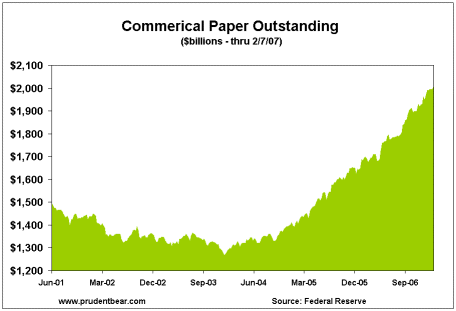
Third, let's note the critical role real estate ownership, sales and high valuations play in funding local and state governments. Government at all levels is about 25% of the U.S. economy, though in many locales it's more like a third. As mortgage rates rise and credit tightens, real estate sales fall, cutting transfer taxes; as prices fall, homeowners demand lower assessment values, further reducing tax revenues. And as frequent contributor Harun I. noted in submitting this link, local governments desperate for property tax payments are rushing the foreclosure process, dumping the foreclosed (and often trashed) home back on the lenders or builder, who then has to pay the taxes themselves before they can even auction the property off to a new buyer: Hundreds delinquent on taxes: In the Village I No. 2 district, between 5 and 6 percent of homes are delinquent while about 14 percent are late in Fairview Village. In Patterson, the delinquent taxes make up 16.43 percent of what residents in the subdivisions owe.Let's say you're a lender or builder on the edge of bankruptcy. (Yes, there are many more than you might imagine. Please see Aaron Krowne's Mortgage Lender Implode-O-Meter site for more.) You suddenly get hundreds of overdue property tax bills to pay, in cash, before you can even put the distressed houses on the auction block. Might these hundreds/thousands of property tax bills be the straw that breaks the lender's back? Believe me, the bills in California are humongous; multiply $10,000+ a year by thousands of foreclosed McMansions and you come up with some serious money due the local governments. And who, pray tell, will pay the tax lien when the lender (owner of last resort) goes belly-up? Sure, the bankruptcy court will pay the liens, but only if there's enough money left to do so. But what if the lender is well and truly stripped of cash/assets? Then what? The local government eats the taxes due--unless they try to collect in escrow when a new owner buys the property. This may work if you're talking about a $500,000 property with a $10,000 tax bill, but what happens if the process drags out, and the tax bill grows ever larger? The net proceeds from the eventual sale (assuming a buyer can be found) might well be most or all of the proceeds, leaving the holder of the mortgages with a mere fraction of the principle and none of the interest. But isn't the value of all those trillions in mortgage-backed securities based solely on the income streams generated by mortgages? What's their value if those streams dry up? That's right, the value of those MBS and all the derivatives downstream drops--a lot. And when that happens, a credit contraction or crisis occurs. For an excellent description of exactly how this can unfold, I reprint (with permission) a commentary by Karl Denninger, proprietor of the insightful Market Ticker and several other sites. I think people have been trying like hell to keep the credit market bombs quiet, and they succeeded - until this evening, when it came out that Merrill seized $400m worth of Bear's Hedgie bonds.To summarize: Say I'm a pension fund manager seeking higher yield (alpha) so I buy $100 million tranch of a mortgage-backed security, which a rating agency has, in its infinite wisdom, rated AA. My fund isn't allowed to buy less than AA, so everyone's happy. Until the underlying mortgages slip into default. Oops, the income stream is drying up. Now what? Well, there's no market for this security-- no "mark to market"--so I can hide my little mistake in the portfolio, keeping the $100 million value on it (and not coincidentally, my job). But alas, all good things come to an end, and when the rating on the MBS is dropped to BB, I have to sell it--or try to sell it. A frenzied calculation is made. Hmm, it seems the open-market value of this risky security is $5 million, tops. Not only do I lose my job, but the pensioners depending on the fund growing and producing income are in for a shock. The fund just plummeted in value and can no longer meet its pension obligations. Sorry, folks; I was just seeking alpha. Let's check the quarantine. Foreclosed homeowners: financially destroyed. Bankrupt lenders and all their employees: ditto. Local government: facing sharply reduced tax income. Since 80% of local government costs are for employees, then the only choice is lay-offs. Pension funds: income and value drop, causing pensioners to accept cuts or current employees to pony up much higher contributions--or both. Credit markets: in full panic, new loans and mortgages made only to the very lowest-risk, premium customers--in other words, a big chunk of potential home buyers can't borrow money at any price. And let's not forget how precariously perched the U.S. household is on the threshold of insolvency: 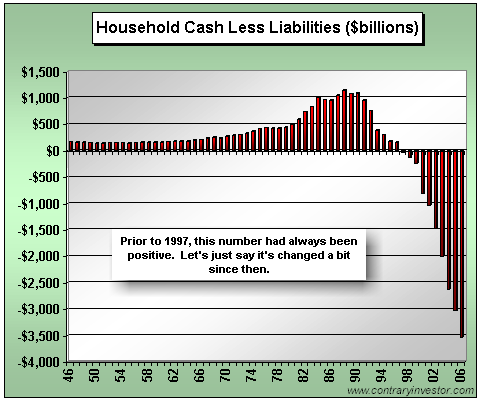
I'd say the quarantine was a failure, as the disease seems to be spreading like wildfire. There's one last critical context: the Treasury. 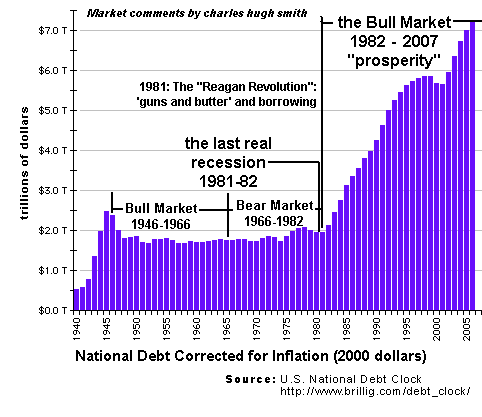
As I have endlessly explained, the Treasury's job is not to keep mortgage rates low; that's up to the bond market. The Treasury's job is to sell government debt via bonds--at whatever the market demands. As I have said many times, there is no Plan B. If no buyers take the bonds off the Treasury's hands at 5%, then they raise the yield until buyers appear. So everyone who is absolutely sure interest rates will drop as the economy plummets is off the mark. Rates might drop, if there's a panic "flight to quality" to Treasuries. But if there is no longer hundreds of billions in easy money sloshing around the world--i.e., the credit contraction is global, and there is no reason to think it won't be--maybe there won't be enough cash laying around to fund our government's enormous appetite for deficits/more debt. That thought is completely alien to a market which assumes the world will forever be awash in cash seeking a return. But when the credit markets turn, and fear replaces panic, then cash dries up--not just cash for mortgages, but even for Treasuries. Since there is no Plan B to fund the government debt, rates will rise, regardless of the impact on the U.S. housing market. The U.S. housing market is a sideshow; the main event is the global credit market. If you'd like more context on real estate bubbles, knowledgeable reader John Brennan recommended this insightful academic paper from 2002 Bubbles in Real Estate Markets by Richard Herring and Susan Wachter (Wharton School). If you found value here, perhaps you'd like to Your readership is greatly appreciated with or without a donation. This Week's Theme: Context What Makes a Bubble? June 19, 2007 New Readers Journal: Nurse Dorothy on sleepless hospitals. Here is an excellent description of the present: Shares rose faster than at any time during the century. House prices were also climbing sharply, producing a boom in the construction of suburban mansions. The Republic lost some of its Calvinist austerity as its people became a nation of consumers, mixing their love of display with an avidly speculative pursuit of wealth.The present it describes is Holland in 1635, at the height of the Tulip Mania. With some very minor editing, this is a quote from Devil Take the Hindmost: A History of Financial Speculation The key context for manias, bubbles, crashes and financial panics is of course the human mind. To quote again from this book: Speculators were, in Vega's words, "full of instability, insanity, pride and foolishness. They will sell without knowing the motive; they will buy without reason." Vega's speculators exhibit many of the features associated with the full range of manic-depressive behavior. A manic-depressive experiences violent and uncontrollable mood swings. As his expectations grow increasingly unrealistic, the manic becomes careless and this precipitates his downfall. Unable to see the broader picture, he becomes fixated on insignificant details.That's a very good description of the psychology of greed and fear--emotions shared by all humans. But what other characteristics of previous bubbles might provide context for our own stock and asset bubbles? Here are three which seem under-reported: 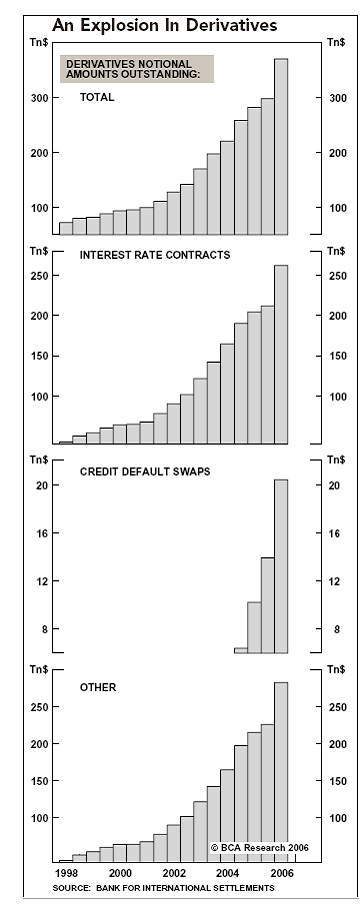
Speaking of insignificant details: Does anyone remember the book-to-bill ratio? During the 1990s tech boom, the semiconductor industry's book-to-bill (orders/shipments) ratio could trigger massive movements in the NASDAQ each month; the report was awaited with breathless anticipation. Now it's merely an artifact of that bubble. Our current insignificant details include phony, manipulated measures of inflation and GDP growth. The initial number is inevitably wide of reality, more a wild guess than truth, yet the invaribaly inflated number moves the market ever higher, even as later downward revisions are utterly ignored. Let's hear a cheer for stock buy-backs! The South Seas bubble of 1720 was based on a variation of the current private-equity/stock buy-back bubble. In our present bubble, it works like this: you borrow $1 billion based on company assets--the value of its outstanding shares--and then you buy $1 billion of shares back and retire them, effectively reducing the float (supply) of stock. This reduced supply means any demand moves the price of the shares up, boosting the value of the company, which can then support another $1 billion loan. Rinse and repeat. Do you see the circularity of this "Bull market"? Rising prices feed more borrowing which raises values even higher which enables more borrowing which... hmm, is this "value investing"? It's more like crass manipulation by insiders--all perfectly legal and even hyped as a "good thing for current stockholders." As for mountains of derivatives and credit swaps built on tulips which can't be delivered--how about all those CDOs and other mortgage-backed securities? All those instruments are based on the delivery of income and/or principle from tranches of pooled mortgages. If the homeowners stop paying the mortgages, then there's nothing to deliver, and the house of trading cards falls. The same also holds true if the homes are foreclosed and sold "as is" for a mere slice of the mortgage; the promised principle comes up short, and all the promises made to holders of CDOs melt like an icecube dropped in the Sahara. In other words, the "value promised"--the interest and principle--become undeliverable. This triggers demands for payment on holders of upstream contracts (CDOs, credit swaps, you name it) who can't deliver, either. As the bottom layer defaults--the homeowners--so too does the next layer, and the next layer and so on to the very pinnacle of the derivative mountain. This is how you get a crash. All the same machinations were in play in 1635 and 1720. Global trade was extraordinarily vigorous and profitable then, too. "Prosperity" was just as limitless as it is now. But the endgame wasn't decades more of wealth-creating machinations; it was financial ruin for everyone who played until the end. Thank you Adrian and Debby G. ($100.00) for your astoundingly generous and extremely unexpected donation. I am greatly honored by your support. All contributors are listed below in acknowledgement of my gratitude. If you found value here, perhaps you'd like to Your readership is greatly appreciated with or without a donation. This Week's Theme: Context A Semi-Long View June 18, 2007 Allow me to summarize the economic Optimists and Pessimists core positions: Which is right? Or are both right? This week's theme is Context, for establishing the appropriate context goes a long way toward resolving apparent contradictions. In this sense, problem-solving (and forecasting) boils down to assembling a context which accounts for the known facts and the influences of history, culture and events. One philosophic word for this is "totalization" (from Critique de la Raison Dialectique). By way of an example: consider welfare. Those ideologically against welfare focus on those gaming the system (the scofflaws and cheats), and other deficiencies such as dependency being passed down to the next generation. Those ideologically predisposed to support welfare focus on those impoverished children and mothers whose lives have been improved by welfare, and those who successfully transition from dependency to the workforce. But the larger context of welfare must include its size in the overall Federal Budget (modest) and various technocratic methods/policies to minimize cheating and encourage job skills and entry-level employment of people who were previously "hard-core unemployed." Belief systems may drive politics but they don't provide context or understanding. To establish some basic context for any economic forecast, I've drawn a graphic depiction of some major forces which have influenced the global economy over the past 40 years. 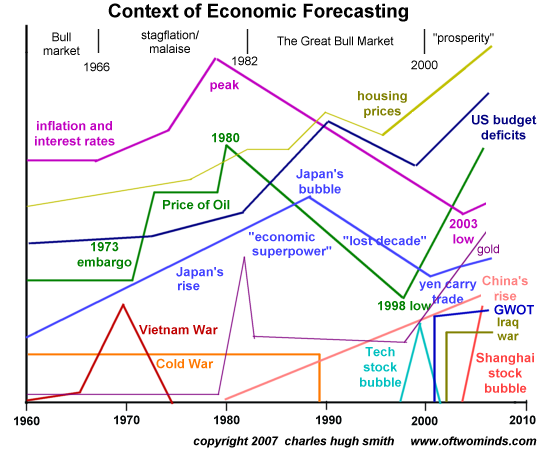
Note that the lines are not scaled, but they do roughly track trends and key inflection points. What seems rather obvious: Is this an exhaustive "totalization"? Of course not. But as a broad-brush sketch, it does serve a purpose, I think, to set the current "prosperity" in a broader context. Thank you Steve M. ($20.00) for your generous and unexpected donation. I am greatly honored by your support. All contributors are listed below in acknowledgement of my gratitude. Corrections and Additions June 16, 2007 Knowledgeable reader Fabius Maximus was kind enough to point out an important distinction between oil shale and oil sands, two hydrocarbon sources which I had incorrectly lumped together: Kerogen -- aka "oil shale" -- is not in commercial production, except in a few pilot plants build with government money.Thank you, F.M., for taking the time to elucidate a key point in a key topic (synfuel substitutes for oil). If you'd like to read more by Fabius Maximus, you can find a number of archived articles at Defense and the National Interest, a very rich source of information on Defense issues, the war in Iraq, the GWOT and much more. Frequent contributor Harun I. added this comment about hedging--an investment strategy I will be addressing as part of my own education on this subject: The futures markets reason for existing is to transfer risk. When commodity prices rise, ceteris paribus, we see those prices increases as end users. And it means we can purchase less of the things we need in effect, changing our standard of living. Prices can rise due to monetary related issues or supply/demand issues which can be complex. But for end users it is simple: they purchase less or substitute.Thank you, Harun, for providing us with additional information on hedging. As a mere pawn in the game of life, I am interested in hedging my "bets"--not just the bets I consciously place in the stock market, but in the involuntary "bets" we all make by being citizens of this country and participants in the global economy: bets in the value of the dollar, bets on interest rates, bets on commodity prices, bets that real estate won't plummet, and much more. Did you notice a whole week went by since you saw this enfeebled, tiresome pitch? A week filled with insightful entries on hedging, France's healthcare system, Oil and the Monkey Trap, and an extra-special bonus rant on national recklessness? Donations of any size or type are gratefully honored, so why not Your readership is greatly appreciated with or without a donation. Gratitude June 15, 2007 If you haven't felt a jolt of gratitude in your life recently, allow me to spark one: be glad you're not in a hospital. I helped another friend pick up our elderly (78 years old) neighbor from a major city hospital after a weeklong stay to treat pneumonia. The release process took about an hour and a half; my friend joked that getting out of jail had to be easier. Being in a hospital is no fun. Is that the result of incourteous staff? No--the staff was uniformly professional and courteous. The un-fun part starts with why you're there in the first place, of course; you feel lousy, and are in pain, and probably very weak. But the experience of being there is not fun, either. Here you are, feeling and looking your worst, lying in a bed facing an open door to a hallway filled with the chatter and clatter of innumerable staff going about their day and night duties, and complete strangers who are free to poke their head in and ogle you at your worst. Across the hall is an open door and another ill person; not exactly a cheery view. There is a window in your ward, but you're not close to it; there is no view of Nature or the outside world to relieve the tedium of being ill in a closed, always busy impersonal world of other ill people and those who care for them. The food is microwaved. You're diabetic, and not hungry, and the protein drink you're given has too much sugar in it. Oops. The doctor says no, the dietician says yes. Take it away. They're confused, and so are you. Every patient has rights; they're posted in a long list on practically every door: to be treated as an individual, blah blah blah. But the right you care about is the one the other patients in your room seem to treasure, which is to play their TV all day and night, even when you hear them snoring. Your request to have the sound turned down--gosh, the other patient might be hard of hearing. Her visitors come in, turn up a baseball game and sit down to watch it for three hours. When they leave, they leave the volume up. It's their right. Other visitors crowd in--younger, even more disrespectful--and one pulls the curtain aside to take your TV remote--yuor TV is off--"since you're not using it." After a protest, your remote is grudgingly returned to you. Are all our rights equal? No, for respect and courtesy are not rights. Consideration, it seems, isn't a right, either. Neither is your desire to sleep a right. We can give you earplugs, Honey. They have their rights, and they insist on them, even when they trample yours. Welcome to America, Baby. I got my rights, and they always trump yours. So we're ready to take the patient home. There are dozens of staffers around, but nobody to get a wheelchair. That's another department, of course. A half-hour later, after three polite requests, the wheels start turning. This is Hospital Time, a version of Hurry Up and Wait. It's interesting, observing the great variety of the staff--every ethnicity and religion is represented, some more than others. But after a while you start wondering why there are hundreds of people at work here but nobody to get a wheelchair. Minute 40 rolls around and the wheelchair and staffer appears. Great. Now we go down to pay the $200 co-pay--that's important. Another long wait ensues while they find her personal effects--her wallet--and carefully count out the cash inside to confirm (sign here) that nobody ripped her off during her stay. Make the payment, and we're off to the Discharge pharmacy. Ah, they were wondering whose prescription this is; there's no patient name or number on it. They will call her doctor. My, what interesting floor tiles; they seem to hold up to wear and tear pretty darn well. Oops, her doctor's not available, we'll find another. Thank you. Some time later it's all confirmed and the medications are handed over. The staffer with the wheelchair has to call her department; this Discharge is lengthier than expected, it seems. Ah, fresh air! Sunshine! After a mere hour and a half, you've forgotten what they feel like. Imagine what it's like after a week in a stuffy room, listening to an idiotic sports channel all day and the constant noise of a 24/7 staff all night. It's hard being a patient; it must also be very hard being a staffer. I would rather dig ditches or carry lumber all day than work in the hospital environment, and I am grateful someone is willing to do so. Home sweet home. The healthy have no idea. Be grateful you're not in a hospital as a patient. Thank you Shawn S. ($15.00) for your generous donation. I am greatly honored by your support. All contributors are listed below in acknowledgement of my gratitude. Recklessness, Security and Fantasy June 14, 2007 New Readers Journal: British medical care, living in unusual times, dying for chastity, the futures market and buying gold. The media and our government leaders (elected and appointed) are constantly reassuring us that our nation, lifestyle and economy are safe and secure. Nothing truly threatens Pax Americana and our global hegemony except the GWOT (global war on terror) which is going well because there have been no follow-up attacks on American soil after 9/11. Our politicos are slightly annoyed by China's huge trade surpluses, but nobody else cares--the shelves are full, housing has bottomed, the stock market is hitting new highs and the indefatigible U.S. consumer has money to spend: retail sales rose yet again, "beating analysts' expectations." I think you either know, or sense, that we are not secure at all, which is why you're reading this site and others like it. Our leadership has recklessly led us to a precipice which they obscure with distortions, cheerleading and/or outright lies. Is this a rant? Is it a rant if everything is factual? It is fact that oil shale and switchgrass are incapable of replacing our 21 million-barrels-a-day petroleum consumption. Yet how often have you read this simple fact? Buried in the fine print, so to speak, you might read that oil shale produces 2 million barrels a day, and that much of it has been contracted to China and the nation where it is processed, Canada; but unless you already know the U.S. uses 21 MBD, then it might seem like a lot. But the simple fact is we as a nation will be fortunate to get 1 million barrels a day from these "bigger than Saudi Arabia" oil reserves. In the big picture, 1 MBD isn't enough to make a difference. Yet you will never read a media story or hear a government official place the oil shale fields in a realistic context. Why? Because it might suggest the reality, that we are extremely dependent on a handful of quasi-allies or unstable regimes for our daily "fix" of 25% of the globe's petroleum consumption. Even worse, the super-giant fields in Mexico and the Mideast which we have been depending on are already declining in daily production; in other words, they've peaked and will only produce less every year from now on. (The links documenting this can be found in the 2007 Archives.) Is this mere oversight? Of course not, any more than the headlines blaring that housing prices are still rising is an oversight. Does the story contain an explanation of how a few mansions selling for millions can skew the median price upwards, even as 90% of the houses sold have declined in price? No, it doesn't. The truth is a gigantically profitable debt/lending machine has been recklessly unleashed to chew up anyone foolish enough to believe the endless hype about "the ownership society" and "housing never goes down." Should there be any regulation whatsoever on lending standards? How about on "saving" the lenders who foolishly handed billions to unqualified borrowers? No? Yes, let those greedy lenders go down--and all their CDOs and credit-based derivatives, too. But guess what, folks--those uncollectable debts are held by your pension fund and your 401K mutual fund. The bankers who issued the CDOs weren't stupid enough to hold them--they sold them to pension fund managers "seeking higher returns." So when the debt bubble pops and untold billions vanish, it will impact millions of people who were misled into believing their pension and 401Ks were "safe." Frequent contributor U. Doran sent in these three stories on the topic: Banks Sell 'Toxic Waste' CDOs to Calpers, Texas Teachers Fund Property Taxes, Retirement Promises, and Municipal Bonds Fears over helping hand for mortgage defaulters The lending spree was not safe--it was reckless. If you read the last story, you will come to understand how the reckless risk is being hidden--at least temporarily. Mr. Doran summarized the situation with a quote by Warren Buffett: "It's only when the tide goes out that you see who is swimming naked." The war--oh, right, we are at war, aren't we? Eight U.S. soldiers killed today, ho-hum. What's on sale? The newspapers are filled with glossy ads for luxury goods and expensive real estate, and cultural "news" about hyphy hip-hop (worthy of coverage, or merely a desperate attempt to snare some younger readers? It's your call), celebrities of one flavor or another, fancy food fetishes, and what's on TV. Oh my gosh, The Sopranos! How many Americans know someone in Iraq? How many see the eight KIA and feel a chill of fear? Not enough, it seems, to cause a ripple in the body politic, which seems to accept that the war was recklessly launched without prudent planning--but oh, well. Frequent contributor Michael Goodfellow sent this link to a detailed depiction of the U.S. Federal Budget. Find the interest paid on the National Debt: The Budget Poster. Now calculate what the annual interest will be if interest rates rise--a thesis I have covered here in detail for months. We currently pay $261 billion in interest on the National Debt, which is money borrowed via Treasury bonds to fund the accumulated deficit--a number which has risen by trillions in the past six years of "prosperity." It would only take a modest click upward from 5% to 7% for the interest cost to rise to $360 billion--roughly equal to the entire cost of Medicare. These are simple extrapolations, but in the recent past, interest rates in the range of 7% to 9% were considered normal. To claim that the recent period of multi-decade lows in interest rates is now permanent is, well, a lie--as rising rates this very week attest. Do you think adding trillions in debt during six years of super-low interest rates was prudent? Or was it reckless? When we're paying more in interest than for Medicare, I think it will be abundantly clear that it was reckless in the extreme. I have mentioned our friend who recently discovered she had a large brain tumor. Surgeons removed what they could of the tumor, but much remains intertwined in her brain; she lost the hearing in one ear and some feeling in her face, and has experienced short-term memory loss/damage--all in all, not much loss for such an invasive operation. Now she must gain strength to face radiation treatment, where it is hoped that most or all of the remaining tumor can be destroyed. Our friend works for a Fortune 500 radio/billboard company based in the U.S. If she is unable to return to work because of various motor-control or short-term memory issues, she will be "let go" (such a polite term!) and her medical insurance cancelled. She can opt for COBRA, but as you probably know, COBRA is outrageously expensive and only short-term "gap" coverage. Our friend has worked all her life and paid taxes; she has a 15-year old son. So what "safety net" is there for her when she is let go and her healthcare coverage vanishes? I assume she can apply for Social Security disability, but what about medical coverage? I have no idea just what coverage is available through any government program for a 45-year old woman who may be unable to work, or work at her previous wage and level, ever again. But I do know there shouldn't be any doubt that a U.S. taxpayer in her situation should not have to be destroyed financially before some "safety net" is available. Yes, her family is doing all they can, but the medical costs of her treatment, once her coverage lapses in a few months, will bankrupt any family unless they are multi-millionaires. Is this a national "safety net" we can be proud of? Is it "secure"? Maybe if you're lucky enough to reach 65 years of age, but what about if you're 45 and losing your job and coverage? Is it too bold and "politically incorrect" to say that our medical and healthcare system is recklessly insecure? That it is an embarrassment that we spend the most of any nation on earth as measured by percentage of GDP expended on medical care (15% compared to France's 10%), yet if a taxpayer is struck down with a chronic condition in his/her middle years, he/she will be thrown out of coverage right at the moment they need it most? Yes, I am disgusted by the constant reassurances of the media and political hacks like Greenspan that everything is just peachy and safe and secure; I am disgusted that the realities of our national recklessness are swept under the rug or mentioned in context-free (and therefore purposefully obfuscatory) stories buried deep on page C-11. According to the current Atlantic magazine, which cites a Pew Research Center study, only 32% of the American public are aware that Sunni and Shia are the two main branches of Islam. Sure, Americans don't read anymore, but you also have to wonder: is the "news" they're watching and reading so execrably distorted that they are brainwashed as much by what they're not told as by what they are told is "true"? Yes, housing has bottomed--it's been announced monthly since the "top" was identified. In the last housing decline, the "bottom" was duly announced in 1990, 1991, 1992, 1993, 1994, 1995, 1996 and 1997--at which point it became more or less true. Eight years of lies by industry spokespeople and various pundits, breathlessly (and uncritically) repeated by a media desperate for revenues from the real estate industry, which goes to show that if you repeat the lies long enough, they might just become "true." Here are the fantasies: there is plenty of cheap oil for decades, if not hundreds of years. The supplies are safe and secure. The healthcare system in the U.S. is the finest in the world. The war in Iraq is all about bringing democracy to the Mideast. Our financial system is very secure, and derivatives cushion the system against risks. The housing bubble has popped, and now is a good time to buy. Buy on the dips, as the stock market is in a Bull market which has decades to run. Do you sense security, or merely recklessness well-cloaked? Thank you Renee St.-J. ($10.00) for your third generous donation. I am greatly honored (and astonished) by your continuing support. All contributors are listed below in acknowledgement of my gratitude. The (Hairless) Monkey Trap June 13, 2007 Our U.K. Correspondent (now first among several) recently recommended a fascinating essay Faustus and the Monkey Trap (March 27, 2007) from a thought-provoking site. Here is an excerpt which describes The Monkey Trap and relates it to humanity's attempts to find a replacement for petroleum: Many centuries ago in southeast Asia, some clever soul figured out how to use the thinking patterns of monkeys to make a highly effective monkey trap. The trap is a gourd with a hole in one end just big enough for a monkey’s hand to fit in, and a stout rope connected to the other end, fastened to a stake in the ground. Into the gourd goes a piece of some local food prized by monkeys, large and solid enough that it can’t be shaken out of the gourd. 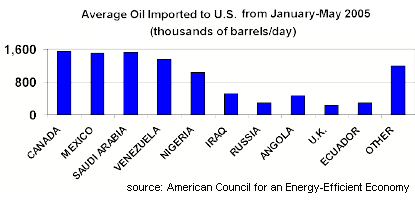
Resource Analyst (and frequent contributor) U. Doran provided four excellent links which encapsulate Peak Oil and its many ramifications beyond energy consumption: Peak Oil: A Detailed and Transparent Analysis Crying Wolf or Crying Uncle Does our dependence on foreign energy and credit really matter? HIGH GASOLINE PRICES Part 1: Immediate Causes HIGH GASOLINE PRICES Part 2: Long-Term Factors You have probably heard that producing ethanol produces only a fraction more energy than the oil needed to produce, harvest and transport the corn, make the ethanol and then truck it to market. Furthermore, ethanol contains significantly less energy than gasoline, as this excerpt from the above story describes: It is a fact that ethanol only contains about 65% of the energy content of gasoline on a volumetric basis. Therefore, to displace the gross energy content of 1 gallon of gasoline requires 1/0.65, or 1.5 gallons of ethanol. What this means is that as ethanol is put into the gasoline pool, demand will go up simply because the pool now contains less energy.Gasoline has nearly the same energy density as TNT--meaning that substitutes for such a powerful, currently cheap and easily transportable energy are rare/non-existent. 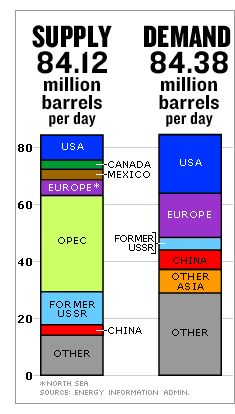
Here are two previous 2007 posts on Peak Oil/energy: Peak Oil: Denial Won't Fill Your Tank (April 12, 2007) The Future Shortage of Energy (May 22, 2007) Various "technological miracles" are constantly being touted as replacements for oil. One cheerleader favorite is Canadian oil shale/tar sands. But the maximum production capacity of the entire field, at the most optimistic, is 4 million barrels a day--less than 20% of the U.S.'s 21-million barrels a day oil habit. The rest of the world also uses energy--about 84+ million barrels a day. So the oil shale will at best replace less than 5% of the daily global demand for oil. So much for cheerleading "solutions." Now we hear about switchgrass as the "miracle feedstock" for ethanol. Wonderful, but nobody's figured out how to brew the stuff on an industrial scale. And even if the entire nation's corn crop were turned into ethanol (or replanted in switchgrass), the ethanol produced would replace at best about 10% of the nation's daily gasoline consumption. But perhaps The Monkey Trap extends to more than Peak Oil. 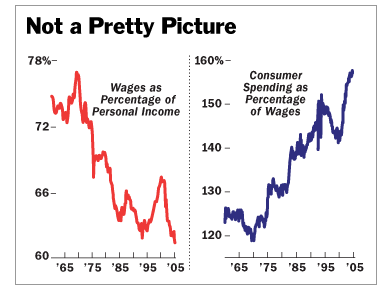
Isn't our entire financial system based on an ever-increasing flood of debt and borrowing, as a nation, and as consumers? As our savings rate has plummeted to a negative number, there is no outcry or concern; The Hunter has yet to appear. As consumers have tapped their primary reserve of wealth, their home, to spend lavishly on luxury goods and travel, it seems we are close to extracting the food from the trap and going on our merry borrow-and-spend way. But alas, the trap is stronger than our fantasy that we can pay back debt by borrowing and spending more. The seed corn (home equity) is gone, and now that our hands are firmly stuck in the trap, The Hunter--in this case, the bond market--is finally approaching its prey. Thank you David C. ($20.00) for your generous donation--and your excellent suggestion on how to spend it. I am greatly honored by your support. All contributors are listed below in acknowledgement of my gratitude. What Can We Learn from France About National Healthcare? June 12, 2007 I asked correspondent/author John Kinsella, a resident of France for many years, for an "on the ground" account of that nation's healthcare system. I think you'll find his comments most interesting, as they relate to our own debate on how to provide affordable healthcare to all. Frequent contributor Michael Goodfellow, whose own practical and insightful essay on the subject can be found in the Readers Journal sidebar to your right, sumbitted two story links on the same subject. The reason I asked Mr. Kinsella for a report is that we hear a great deal about the national health care systems in Britain and Canada, but very little about France's, which is an entirely different model than either the U.K. or Canada. Here is Mr. Kinsella's commentary: If you were to question the average French man or woman’s opinion on their country’s health system you would no doubt be met by a deluge of criticism. Besides the fact that criticism of the country’s institutions is a national pastime, this is a rather curious attitude, since by international standards the system is judged one of the world’s best according to the World Health Organisation after that of Sweden, Finland, Norway and Japan, with the United States in the 14th position.Thank you, John, for an excellent precis of an extremely complex subject. Michael Goodfellow sent in this story critiquing Michael Moore's latest film, Sicko, which relates to the French as well as the British model: Sicko or Wacko?Michael also submitted this report on long waits for care in the U.K.: Waiting list crisis as NHS cuts costs:Michael's comments: 18 weeks is an astonishingly long time to be sitting around waiting for surgery! And this was for "inpatients"! So these people are already in a hospital, and waiting 4 months for treatment? Worse in a "trauma and orthopaedics" wards? Am I correct in thinking of accident victims warehoused for months before they can get corrective surgery?One would hope not, but it's in our interests as a nation to find out as much as we can about the real-world practicalities of alternative systems before making ideology-based decisions pro or con. Thank you Schahrzad B. ($15.00) for your generous donation--and your many contributions of topics and commentaries. I am greatly honored by your support. All contributors are listed below in acknowledgement of my gratitude. Retiring in an Era of Declining Purchasing Power June 11, 2007 I asked frequent contributor Harun I. to briefly address a topic which has long concerned him: the impact of our declining purchasing power on those with fixed incomes, and what hedging strategies they might use to lessen such losses. In terms of what one share of the Dow Jones Industrial index buys in commodities, the "new highs" in the stock market are nowhere near new highs in actual purchasing power; our dollars buy less and less actual goods, despite the endless cheerleading we are constantly bombarded with about "low inflation" and "the strong dollar." Here is a chart which prices the Dow Jones Industrials Average in gold as well as dollars: 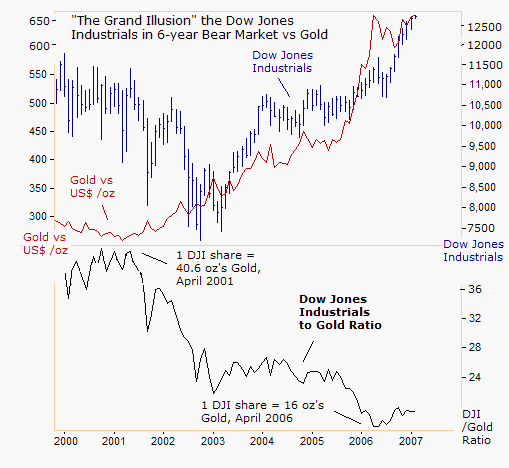
One key concept here is the idea of hedging one's retirement income by buying and holding gold and/or non-dollar currencies, and prudently purchasing commodities or energy futures as hedges. In other words: by moving dollar assets to gold and other currencies, and purchasing futures, you may be able to retain far more purchasing power than if you left your nestegg in dollars or dollar-denominated bonds. Here are Harun's comments, which reference an Excel spreadsheet that opens in a second window. (If this link doesn't open, try this HTML version, or download the file and open it in the appropriate software.) If you study the spreadsheet you will notice that, if you retired with 1 million dollars in 1986 you would have had pretty good purchasing power. Left un-hedged that purchasing power dropped off dramatically. I didn’t adjust for any interest received because at these numbers it wouldn’t have mattered much. Even if you had 1 million is bonds at 6% throwing off 60K/yr., you are still living on a fixed income. I didn’t adjust for taxes or commissions either.For another perspective on the loss of purchasing power, here is a chart of the Consumer Price Index components, 1978 - 2004: 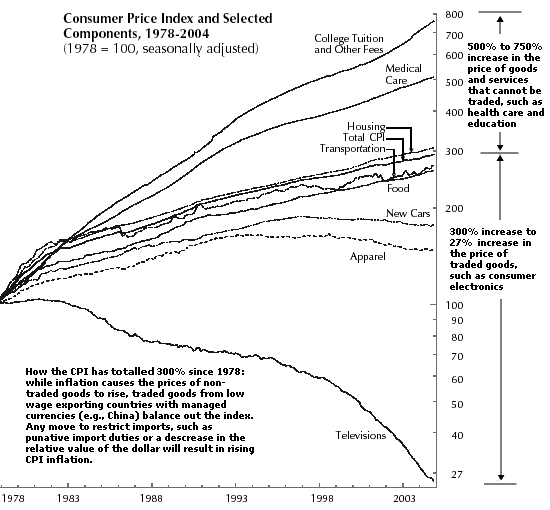
Thank you Don E. ($10.00) for your generous donation--and your readership. I am greatly honored by your support. All contributors are listed below in acknowledgement of my gratitude. The Hazards of Technical Analysis June 9, 2007 The problem with technical analysis of the stock and bond market is the same one which plagues the rest of life: you can always find evidence for what you've already decided will happen. Here are Exhibits A, B and C: three respected technical analysts, all of whom were calling for "more upside" as their read of the charts indicated more bullish action--just days before the market started tanking: Marketwatch analyst Michael Ashbaugh, whose analysis swings all the way from super-bullish to mildly cautious, saw only more bullish gains ahead: Sentiment backdrop favors further upside (June 5, 2007) Barron's Michael Kahn has been warning of a toppy, ageing market for weeks, but he caved in on June 4 and hyped retail stocks--a surefire way to lose money as an exhausted, worried consumer finally gets a grip on reality, i.e. his or her wealth and income is declining daily even as their credit costs are rising: Retail Stocks on the Mend (June 4, 2007) Then there's Ralph Acampora, another perma-bull dating back to Louis Rukeyser's TV entertainment, Wall Street Week; unsurprisingly, Ralph sees bargains galore and a number of stocks set to begin huge multi-year rallies--in other words, same story as always: Charting the Bull's Next Move (June 4, 2007) In contrast, here were the entries you read here, explaining why bond yields had to rise: Why Interest Rates Will Have to Rise (May 30, 2007) or going back a bit further, to January's Inflation/Deflation V: Bonds and the Dollar (January 12, 2007) or March's Bonds, Interest Rates and Gold (March 6, 2007) And why the stock market looked ripe for a decline: Don't Cough (May 12, 2007) The Moon's a Balloon--And About to Pop (May 18, 2007) Stock Market Needs Suckers, John Q. Public Wary (June 1, 2007) Friday, the Bulls roared back, reclaiming over 1% of the week's losses. So does this mean the Bulls are back in charge and the three analysts are absolutely right? Maybe. Here is a 5-year chart of the long-bonds exchange-traded fund, the TLT. If you want to find some bullish evidence in this chart, you have quite a challenge: 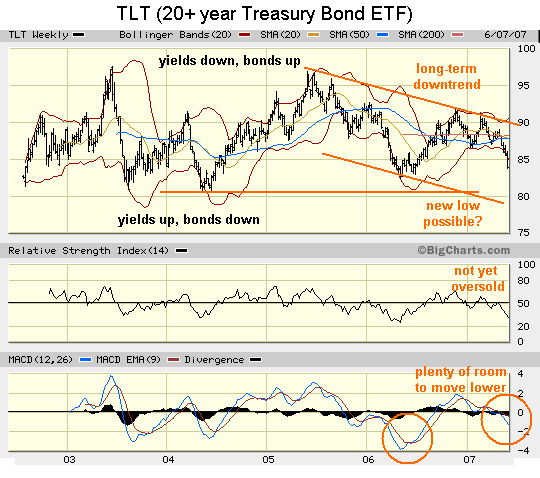
And here's the five-year chart of the Nasdaq, which I prefer over the narrow 30-stock Dow Jones Industrial Average, and the S&P 500, which has been distorted to some degree by the huge gains in financials (housing/mortgage/private equity debt bubble) and energy (oil rising from $20/barrel to $65/barrel). How low the Nasdaq will go this time around is anyone's guess, but the chart offers little support to the perma-bull chartists quoted above. 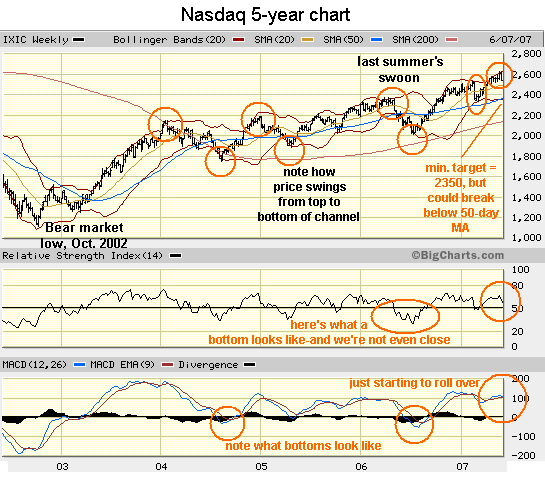
Am I just "finding Bearish cues" in these charts because that's what I've decided will happen? Perhaps--so look at the charts and make up your own mind about what they're indicating. Thank you Richard Z. ($20.00) for your generous and quite unexpected donation--and your readership. I am greatly honored by your support. All contributors are listed below in acknowledgement of my gratitude. If you found value here, perhaps you'd like to Your readership is greatly appreciated with or without a donation. Yes, Real Estate Prices Can Drop in Half--Even in Manhattan June 8, 2007 One of the most enduring cliches of the real estate industry is that properties in "prime locations" such as Manhattan and San Francisco "never go down." Nice idea, but wrong. Let's take a look at a chart, courtesy of www.quadlet.com (link below). I've added some lines and comments to clarify the sobering reality: In the last real estate decline in the 90s, Manhattan prices fell 40% nominally and 60% when adjusted for inflation: 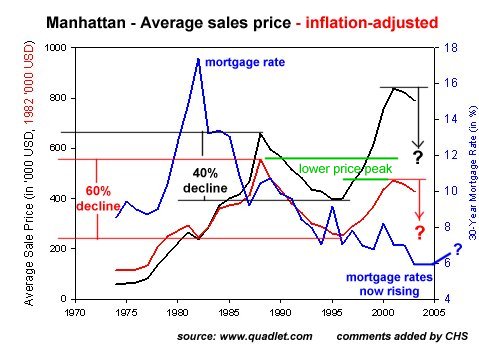
If you need more evidence, then read 100 years of Commercial Real Estate prices in Manhattan (MIT): Then during the 1920s prices rose almost 3% yearly in real terms. The depression saw real prices drop in half, and the 1940s saw them slightly more than fully recover. Real prices dropped about 2% yearly from 1949 to 1969 and then rose 3% yearly from 1969 to the famous peak in property values of 1989. From 1989 to 1999 prices dropped in half – again adjusted for inflation.Note in the above chart that when you adjust prices for inflation, current prices are actually lower than the peak set in the late-80s. Chart technicians would draw an inference from this: "lower highs and lower lows," meaning that the next low in the Manhattan real estate market would be significantly lower (in both nominal and real terms) than the last low. If we extrapolate from history--and we do have 100 years of data--then we can expect Manhattan property--yes, every "prime" square inch of it--to decline 40% to 50% in nominal terms and from 50% to 60% in inflation-adjusted terms. Any way you slice it, that's serious money being lost. Here is the link to the source of the above chart: Are Real Estate Prices Dependent on Mortgage Rates? This data begs one nagging question: if "prime real estate" is set to drop in half, then how far will less-than-prime real estate drop? Thank you Steven R. ($15.00) for your generous donation and your readership. I am greatly honored by your support. All contributors are listed below in acknowledgement of my gratitude. Love in the Time of Syphilis and Master Narratives of Morality June 7, 2007 I have updated the Readers Journal with a selection of lively commentaries in the weekly Journal and a stunning new essay, Love in the Time of Syphilis by Protagoras. I highly recommend reading this essay, as it is filled with thought-provoking themes of human nature, literature and history. The central thesis is that the "master narrative" of sexual morality from 1490 through 1950 was dominated by the very real threat of a terrible death due to the ravages of syphilis, a sexually transmitted and then-incurable disease which could also be transmitted to one's offspring. Protagoras very entertainingly reveals how this narrative, so evident in the literature of those centuries, has been lost to us. What we see with modern eyes as some sort of fusty Victorian concern with chastity and monogamy was in fact a highly practical concern with protecting oneself and one's offspring from an early death or a madness which ended in a cruel decline. The disease was not rare, nor was it limited to the lower classes. Winston Churchill's high-born father died of the disease, to name but one example. In our own time, HIV/AIDS traced a similar narrative in the arts, literature and film, a narrative which is already being blurred or lost as more effective treatments stave off what was until very recently a death sentence. If we take this notion of a "master narrative" that can be lost, and apply it to the malaise gripping the print and broadcast media--the "mainstream media" or MSM--what do we get? What we have now--the collapse of a higher ethical calling. Yes, there is the "news" which is supposed to be "objective." But the unremitting attacks by political hacks (the Karl Rove types of all political persuasions) and "politically correct" interest groups (unions, the elderly, etc. etc.) has enfeebled the media to the point that every story has to be gingerly treated in a "fair and balanced" fashion--in other words, one without any ethical compass. Here's how it works. If the media investigates a right-wing nest of abuse of power/corruption, it's immediately accused of "Liberal bias." If it goes after a Liberal hive of self-serving feeding at the public trough, it's immediately accused of ethnic/gender bias, or even worse, of being "mean-spirited" or "trying to stir up trouble." Duh--that's it's job, people, if "trouble" means exposing what political hacks and con-artists are trying so desperately to hide. The net result: there is no moral center in the media. Here are some stories which have largely gone unreported (by which I mean buried on page B-19, and reported only once), I assume because they don't meet various "politically correct" litmus tests: We are constantly being told the solution to the media's malaise is "local coverage". Like I want to pay a $234 per year subscription to read about hip-hop chess, another pretentious restaurant review or some local politico's pet "feel good" projects. What's lacking is an ethical compass to guide the media to pursue abuse of power or corruption to the bitter end, regardless of what Karl Rove or his lackeys sputter, or which union or PC interest group stands to lose. Raiding the public treasury was once upon a time a Master Narrative of wrong-doing which had to be limited or punished: power being abused, public trust pillaged and special favors rewarded. We now live in a time where this narrative has been lost, where literally everyone from fire department employees, Medicare recipients and providers, Homeland Security (sic) and private Pentagon contractors, hedge funds, the mortgage lending industry--everyone is relentlessly "gaming the system" to pile up their own benefits and profits regardless of the fact they are pilfering from public monies or ripping off the public via other means. Meanwhile, the media stands by, lamely reporting the latest mugging or the latest phony "morality play" about gay marriage staged for distraction by political handlers, while our nation is plundered for personal gain and run aground on the reefs of debt, leaving our children and their children a broken state: broken in the sense of a shattered ethical compass, and fiscally broken in the sense of leaving them with untold trillions in debt which can never be paid off. What will it take to restore some moral core to the media? It may well be that the rise of blogs is the thinking public's reaction to the silly shallow "balanced news" pumped out by the networks and print media. It is in this light that I reprint a recent comment made by frequent contributor Harun I. regarding the media's breathless cheerleading about the "new highs" in the Dow Jones Industrials and the S&P 500 stock indices: It is a great failure of the MSM to not balance their reporting of the Dow’s ‘new highs’ with equal reporting of the loss of purchasing power. The lack of objectivity of the MSM is alarming. That people have to rely on blogs written by concerned citizens and true patriots such as you is quite remarkable. On the one hand I fear for our great nation but on the other I read blogs like yours and know that there are enough good people in this country to get it back on track. Thank you Anthony B. ($15.00) for your second generous donation to this humble site. I am greatly honored by your continuing support. All contributors are listed below in acknowledgement of my gratitude. If All the Gold's In Private Hands, Is a Gold-Backed Currency Possible? June 6, 2007 Readers know from previously posted charts that gold has been a better investment than the stock market for the past seven years. Here is the "new record high" S&P 500 priced in gold, courtesy of frequent contributor U. Doran. 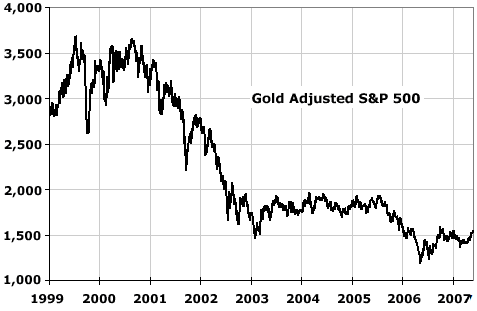
Not so high as the mainstream and financial media makes out, eh? Here is the issue in a nutshell. Forgive my brevity and all the complexity I have left out in trying to compress a deep and critical issue into a few lines. Money supply (money created by "fiat" i.e. by government debt or printing presses) is exploding at 15%+ around the globe even as global growth is 4%. Massive expansion of money supply leads to inflation, which has been officially under-reported for years, though we intuitively know it is rising (and the bond market confirms this intuition). As a result, the cash in our wallets loses value every year. In times of rapid growth of money supply, hard assets such as real estate and commodities skyrocket--exactly what we've witnessed over the past seven years. Another result has been the declining value of the dollar in relation to other currencies--mostly the Euro, which is the only major currency which trades in a free market, i.e. "floats." (The yen is manipulated into a narrow trading range, and the yuan is pegged to the dollar.) If the dollar falls below the "line in the sand" of 80 on the Dollar Index, it could trigger a major decline of 30%-50%. Many observers consider this inevitable. As the dollar weakens, investors and traders start backing away from their reliance on the dollar as a placeholder of value and as a currency used for trading. For instance, Kuwait split raises questions over longevity of the dollar (link courtesy of U. Doran). Net result: owners of dollars (i.e. Americans and overseas owners of dollars or U.S.-denominated debt) find their purchasing power reduced/devastated. Many observers believe a pan-Asian currency will arise to replace the dollar: China, Japan, Korea on single currency unit. Many believe that any such currency will have to be backed by gold to have any "staying power." 
For background on the issue of gold-backed currency, here are three links provided by U. Doran. I especially recommend the first one: The Once and Future Money The End Of National Currency Gold and Economic Freedom (by Dr. Alan Greenspan, 1966) So far so good. But as astute reader Don E. explains, there's a fly in the ointment for any gold-backed currency: most of the world's gold is in private hands: This idea presented itself as a problem last week when I read Anatal Fekete’s commentary on the preponderance of gold having moved from the hands of governments, central banks, to private holders. Gold Vanishing into Private Hoards.Governments can of course confiscate all privately held gold, as the U.S. government did in the 1930s. Yes, it was a crime to own coined gold or bullion in the U.S.A. It doesn't take much imagination to speculate that a nation, or perhaps many nations, could decide to create a gold-backed currency by confiscating their citizens' gold and paying them in paper for the privilege of giving their gold to the State. Not a reassuring thought, to be sure. Thank you Alonzo J. ($5.00) for your generous donation to this humble site. I am greatly honored by your support. All contributors are listed below in acknowledgement of my gratitude. Note to readers: I have of necessity started a new category for financial contributors who have made multiple donations: Heroes and Heroines of New Media, for supporting ad-free original content and the Readers Journal here. If you found value here, perhaps you'd like to Your readership is greatly appreciated with or without a donation. Can the U.S. Go Down and China Stay Up? June 5, 2007 Is China "decoupling" from the U.S. economy such that it can prosper even as the U.S. sinks into debt-bubble-popping recession? Many think so, but I am skeptical. Let's start with knowledgeable reader Peter John Golda's observations about real estate speculation in China: I also confirm your theories regarding Chinese real estate. I investigated this in depth, with the help of my wife and relatives up there on the East-side as I was wanting to purchase some property there. The thing that scared me the most is something you did not really mention directly in your post. Apartments are being flipped at huge profit every 6 to 12 months, sure, but what is scary is that nobody is living in them. It's all 100% pure speculation on a scale that my mind is not even able to comprehend. 
Peter also recommended Dreams Built on Sand: Investing in China Real Estate which lists eight significant (and under-reported) difficulties with real estate investing in China. Xinglongnite added this telling comment to the article: Land and property development has so far been one of very few successful businesses of the local governments and their powerful officials since the beginning of 10th 5-year planning period (2000 - 2005) --- imagine a gigantic entitlement program by a US state to grant unlimited land development and building rights to every local city council member, city manager, municipal judge, sheriff and deputy, and support them with abundant bank credit. The obvious end result would be a run-away property bubble. That is what the major cities in China are heading for.A bubble is a bubble regardless of its location or the nationality of its players. Lending is fast and loose in China, with tens of billions of risky loans being made to local governments and developers. The ability to service those loans, never mind pay them off, once the property bubble pops is virtually nil. As I have reported previously, the "middle-class" friends of our Chinese friends in Nanjing (we have a number of sets of Chinese friends, many of whom we have known for 15 years) already owned three "investment" apartments each even back in 2004. The bullish argument is: China needs 200 million new housing units, so all this building is "natural demand." The problem with this story is only a few tens of millions of wage earners can afford what's being built. A good two-wage family income is $600- $700 a month ( nurse and teacher) while the units being sold are $100,000+. Sure, once the price plummets to $30,000, there will be buyers, but guess what happens to the banking sector when all those bad loans are written off as uncollectible, and to new developments on the planning boards? The other bullish mantra is that the Chinese consumer will soon buy much of the output of its stupendous manufacturing base, so China no longer needs the U.S. consumer. On sheer numbers, this seems plausible, but if you look at reality, there is little evidence to support it. Consider this recent story in Businessweek: Cautious Consumers: The Chinese are on a spending spree, right? Not really. In fact, they're so tightfisted, Beijing is worried. But look beyond the headlines and you'll find that China's 1.3 billion people are actually buying relatively little. Although the mainland's population is four times that of the U.S., Chinese consumers last year spent just 12% of what Americans did, figures investment bank UBS (UBS ). And private consumption as a share of gross domestic product in China is falling, to less than 40% today from about 48% in 2000.That pretty much refutes every bullish argument being made about the sustainability of China's current bubblicious boom. It's important to recall that the majority of Chinese workers do not have a pension nor do they have medical insurance/coverage. The "iron rice bowl" of the pre-1978 era has largely been dismantled. So Chinese saving most of their earnings makes perfect sense. So what happens when the property/debt bubbles burst? Will Chinese investors and consumers be hurt? Will U.S. consumers be hurt when our slow-moving property bubble finally sags under its own weight? Of course they will; it's called the reverse wealth effect, and it works in every nation and era. Some thoughtful commentators believe Asia and Europe will grow so vigorously that they will replace the overburdened U.S. consumer as a buyer of all China's staggering output. But Europe is living off its own real estate bubble, just as we have in the U.S. As for Japan--like its EU export-dependent cousin, Germany, it's enjoying a boom based on selling machine tools and such to China's export machine. Should that export machine falter, then so too will Japan and Germany. Bottom line: when the only consuming/importing nation goes down (the U.S.), all the net exporters will have no one to sell to. You can't all be net exporters forever. In sum: the entire globe is living off of a debt /derivatives /lending bubble of epic proportions. When the global debt/ derivatives/ real estate bubble pops, there will be no safe ground. Thanks to Schahrzad Berkland for suggesting this entry subject. Thank you Kent M. ($20.00) for your very generous and much appreciated second donation. I am greatly honored by your continuing support. All contributors are listed below in acknowledgement of my gratitude. Note to readers: I have of necessity started a new category for financial contributors who have made multiple donations: Heroes and Heroines of New Media, for supporting ad-free original content and the Readers Journal here. A "Free Market" for Labor? June 4, 2007 Astute reader Matthew N. had some very interesting comments on the labor market in reaction to the May 24 entry Health, Healthcare and Bankruptcy: Hey Charles, I was thinking about something related to your article. Lots of the downward pressure on wage growth and stagnant wages, as I see it, is from global competition. Heck I know there is someone in India that can do my job cheaper. I already compete with guys in China for what I do (architectural visualizations) ans can't really argue when a guy in China is doing my job for a couple bucks a day. 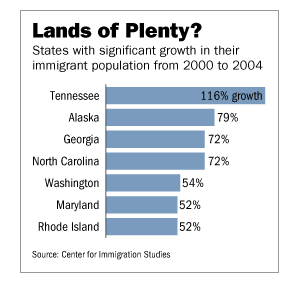 Excellent points, Matt. I will start my comments with a chart, showing the rise of
"imported labor" in states far from Texas and California.
Excellent points, Matt. I will start my comments with a chart, showing the rise of
"imported labor" in states far from Texas and California.
What we see here is employers hiring immigrant labor at a furious clip. Note that this chart does not break out legal immigrants from illegal immigrants, so we have to be careful to differentiate between the two: the first are hired legally, and pay taxes. We should also note that statistics on "black market/cash" jobs and employment of illegal immigrants are unreliable. As a Devil's Advocate observation: isn't buying illegal drugs and hiring illegal workers more or less the same thing? Both are illegal, yet the demand is high for both. In both cases, the government always tries to limit the supply rather than decrease the demand. If the poor wretched fools buying cocaine got a healthy life and stopped buying coke, then the supply (and the price) would both decrease. Yet our government has wasted approximately $100 billion of our taxes fruitlessly trying to limit the supply with essentially zero success--except to keep the street price artificially high. High fives, guys. You've accomplished nothing. Trying to limit the supply of illegal (read cheap/profitable) workers is similarly spectacularly unsuccessful/a huge waste of money. You want to stop illegal workers? Then turn 100,000 special agents loose on the American landscape investigating employers, not their workers. Throw the employers in jail and fine them $1 million per worker per incident. You will quickly find the demand for illegal workers dries up. Why won't this fly? Because employers are reaping immense profits paying workers $10/hour cash rather than $30/hour "total compensation" to legal workers (wages, taxes, FICA, workers comp, disability insurance, etc.) And who donates big bucks to the politicians ranting about illegal labor? The same people who are hiring the illegal workers and profiting from their black market "purchase" of "illegal labor." Here's an example from real life--my own. Back in 1976, as a young carpenter, I was earning $7.50 an hour. According to the Bureau of Labor Statistics inflation calculator, this works out to $27.24 in today's dollars. Add in the overhead (workers comp, state disability, 7.5% FICA, etc.) and that's about $40/hour. A more experienced "lead" carpenter would be about $50/hour in total labor costs (this is without medical or retirement benefits). The contractor's overhead and profit is on top of this, of course; thus in Northern California, contractors charge $55/hour for semi-experienced labor. This is not laborers or contractors getting rich--this is just keeping up with $7.50/hour 30 years ago and paying the overhead expenses. Now I know semi-skilled illegal workers are paid as little as $10 - $12/hour locally--a mere 1/3 of a legitimately employed worker (immigrant or born-in-America). Do you reckon the contractor plugged his "actual cash costs" in his bid? Ha. That's the gravy, buddy--the pure profit raked in by the employer. Sure, maybe he underbid the legit employer by 5% to get the contract, but he certainly didn't price in illegal workers' actual pay scales on the bid. He put in $35/hour and pays $12/hour cash--a very sweet deal for the employer. Consider, too, the regional differences in pay. Wages in high-cost areas of the country are, as Matt noted, higher because the worker actually has to live there. In areas of the U.S. with lower living costs, maybe the legal worker costs $15/hour and the illegal $10/hour--still a nice "discount" to the employer. But in high cost areas, then the illegal wage is maybe $12/hour, but it replaces a $30/hour wage: a much larger "discount." How do illegal workers live in high-cost areas? they live in shabby enclosed garages, or six to a one-bedroom apartment (that rents for $1,000 or more in California). They do what they have to do to send money home to support their families. They are merely "free labor" moving through a "free market." I expect some will argue that businesses can't survive if they paid legal wages. If this is true, then they should get their political act together and start making their realities known to the political classes. Yes, we all know running a small business in a high-tax state (on top of high federal taxes) is generally a thankless struggle. We (small business operators) pay lots of tax and get little recognition as the broad supporters of the tax base. (The corporations can flee to Delaware to Burmuda, but we're stuck here paying local taxes and fees.) I understand this; I have been self-employed for 23 of the past 30 years. But as Matt suggests, paying cash/no taxes is a sweet deal for the employers, and a pretty good deal for the illegal workers, too, at least until it comes time to retire and they have no Social Security or Medicare benefits because they worked in the black market their entire lives. That is hardly fair or a "good deal" except for the employer who skipped out on paying the taxes. There is one more pernicious result of employers being able to hire illegal workers freely: they lower the price of services below the operating cost of legitimate businesses. I am sorry, but I have no sympathy for employers claiming they can't afford to hire legal workers. If they stopped underbidding, then prices would rise to levels which support legit businesses. For example: a few years ago I paid a legit tree-trimming contractor $1,200 to trim a couple of trees. It was a fair price for a legitimate contractor running a real business and paying the usual overhead and taxes. I could have found a black-market tree-trimmer for less, of course, but it was my decision to support guys like myself. That's every consumer's choice. But should we allow black-market types to hire illegal labor for 1/3 the going price, and allow them to drive out all legitimate employers? That is what's happening. And guess what, "price-conscious" consumers-- there goes your local tax base. Now you're going to have to pay all the taxes for services yourselves, because you've destroyed the legit businesses and employers who used to pay all those taxes and fees without you even noticing it. Thank you Glen H. ($20.00) for your very generous and much appreciated donation. I am greatly honored by your support. All contributors are listed below in acknowledgement of my gratitude. Note to readers: I have fallen behind in replying to email and posting comments to the Readers Journal. My apologies, and I hope to catch up later this week. All reader email is greatly appreciated. The Uncertainties of Creation June 2, 2007 Every year, tens of thousands of novels and screenplays are written, tens of thousands of songs are recorded, and hundreds of independent films are shot, often funded by credit cards. With high hopes for recognition and perhaps fame and wealth, the creators send their best work into the dispassionate maw of the Next Big Thing Machine: the talent and literary agents, the publishers, the film festivals, and the media, which now includes the Web. Of this vast outpouring of creativity, a few thousand novels will be chosen for publication, a few hundred movies will be made, a few dozen indie films will be selected for distribution, and a few hundred musical offerings will be picked up by the major labels. The rest will be self-distributed in relative obscurity, or gather dust; most will rest in boxes until the creators relinquish their hopes, or move, or die, and then their best work, the stuff dreams are made of, to steal a great line, is carted off to the dump. Understandably, this isn't what you're told in film school or Creative Writing programs. But nonetheless it is the truth. Occasionally some work rises from obscurity to recognition of genius at a later date (almost always after the creator dies in abject poverty, tortured by failure), but few of the hundreds of thousands of books, screenplays, songs, plays, paintings and other artwork created every year will enjoy this belated success. So why do people persist in creating works which will never find an audience, much less appreciation? To pursue a dream, of course; hundreds of thousands of boys dream of rising to the elite ranks of the NFL or the NBA, their hopes obscuring the grindingly poor odds of joining a group of several hundred in a nation of 300 million. Others dream of other flavors of elite success: on the stage, in Hollywood, on concert tours, in literary circles. This is an essential part of human nature: to dream, to hope and to create. Just as Schumpeter's "creative destruction" lies at the heart of innovation and wealth creation, so creative failure lies at the heart of the Next Big Thing's relentless winnowing. There's another reason: because they have to. My friend of 37 years Gary Baker recommended the film American Splendor As Gary told me after I'd seen the film: the guy had to create. It wasn't for fame or glory or wealth (this individual worked as a file clerk for the Veterans Administration his entire career)--it's because he had no choice. This is the heart of the story, and the heart of the process. If you really have no choice, then you create not by struggling but by opening the floodgates of what fountains up within you, unbidden. Will everyone who has no choice be blessed with success? No, just as not every pretty girl will be discovered by a talent agent while waiting in line at a supermarket. (Yes, that happens, too.) Luck is always in play, as is timing. The mood of the era and audience can suddenly change, and those who found every door slammed in their faces for years (think Andy Warhol) are suddenly famous beyond anyone's imagination, the toast of the town and indeed the world. From this perspective, there is nothing sad about the creations which will never be read, or heard, or seen; just as a tree throws off millions of seeds and only a few seedlings sprout and grow to maturity, so it is with the arts, and indeed all human invention. I should confess here that I completed two novels this year, after years of what passes for labor. (That is, the sort of fun which requires discipline and effort.) The odds of either being published are vanishingly small, and even if that great hurdle should be leaped, then the odds of either book finding an audience is even smaller. This is reality, and if this sober reality causes any hesitation in the creator--well, perhaps it isn't something you must do. I must also confess to being worn out by the process of writing several hundred thousand words this past five months, plus cobbling together this site and doing the work I do to pay the bills. Like many of you, I arise early and work late; but unlike you, I am a complete idiot, and do so mostly without pay. Why? Because I have to, I guess. There's no other explanation for such supreme idiocy. Stock Market Needs Suckers, John Q. Public Wary June 1, 2007 The essential feature of any stock manipulation is distribution: selling the pumped-up over-valued stock to willing (gullible and greedy) speculators. This mechanism is beautifully described in Reminiscences of a Stock Operator At the top of any market, insiders are distributing/selling to suckers. As I documented in The Moon's a Balloon--And About to Pop (May 18, 2007), we have abundant evidence that insiders are unloading their over-valued shares at a furious, even desperate pace. There's just one problem for the Wall Street crowd: there's no final batch of suckers willing to take the shares off their hands! At the top of the 2000 Nasdaq tech-stock bubble, John and Suzie Q. Public were ready buyers, as the millions of IRA and 401K accounts still sporting huge losses in tech stocks attest. But John and Suzie Q. have wised up, and are simply refusing to buy into the current rally. They seem to recall being suckers seven years ago, and aren't interested in playing patsy again. Frequent contributor U. Doran sent in two stories which document American's refusal to jump on Wall Street's bogus band wagon this time around. Here is one Mr. Doran calls "a perfect call for a top": S&P's run: A record for a new era (USA Today) Americans are putting 9 out of every 10 of their investment dollars into international funds rather than the U.S. stock market--a rational bet, it would seem, against the faltering dollar. So Wall Street is confounded--we need a batch of suckers, and the public is refusing to play. Yikes! The Con Before the Storm The insiders are now so desperate for suckers that their media toadies are rolling out story after story that are basically pleading with the public to "buy" a super-bullish scenario. The classic example is the recent Wall Street Journal front page piece which trumpets the views of a Nobel Prize-winning economist that "this time it's different," and that the global growth and easy-wealth-generation machine isn't about to explode, it's about to enter an era of permanent happy-happy times--But only if you cave in and buy my over-valued shares today! Why Market Optimists Say This Bull Has Legs: Vernon Smith, a Nobel laureate economist, is so bullish on stocks that he's put money in small drug companies -- investments he "wouldn't have touched in the late 1990s," he says. Louise Yamada, a longtime Wall Street market analyst, sees the Dow Jones Industrial Average climbing to 16000 as part of a bull market that she compares with the post-World War II boom. Fritz Meyer, who develops investment strategy for AIM Investments, a $149 billion money-management group in Houston, sees stock gains stretching as far as the eye can see.It must be very frustrating for the insiders. Here they generate a massive rally, and nobody believes it's sustainable. Dang, how could they tell? The insiders and their media toadies are literally pulling out all the stops to keep the market rising upward and the "story" compelling: So who is buying the rally? The insiders. Here's why and how. Say you're an insider and want to sell a vast horde of your free stock-option shares. You are your pals push the stock high enough to generate interest, then you place bullish stories in the mainstream media. The public buys the con and you unload your shares. But the public is refusing the con. So you move to Plan B. What's Plan B? Buy your personal shares with corporate "buy-back" money. Yes, buy it from yourself, but with other people's money. Corporate buy-backs have hit an unprecedented high over the past three years: corporations have bought back hundreds of billions of dollars of their own stocks. Was this really the best "investment" of shareholder cash? Were there no investment opportunities in the whole wide world that were better than your own shares? Not if you needed a buyer for your own shares. How about giving the shareholders a huge cash dividend? No way--we make the big money by unloading our free shares. And if we have to use corporate cash to do so--hey, why not? The insiders are still hoping to con the public into playing sucker, and the recent rise of the S&P 500 beyond its March 2000 high seven long years ago is the perfect opportunity to trumpet the amazing profit potential of buying shares at the top. But consider this chart of the stock market in previous Bull Markets, and note what happens seven years after the collapse of the bubble: 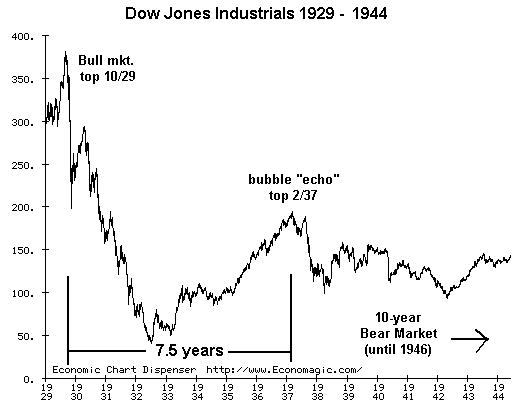
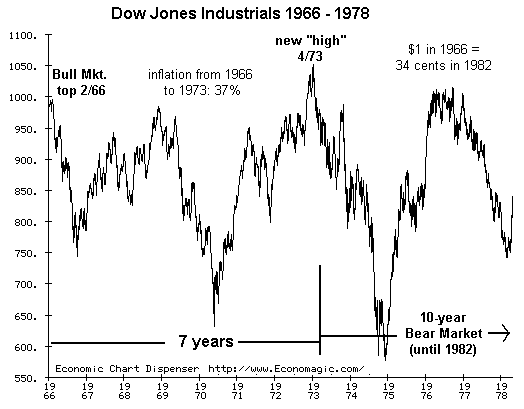
Thank you Gary K. ($10.00) for your generous and much appreciated donation. I am greatly honored by your support. All contributors are listed below in acknowledgement of my gratitude. Why China's Growth Is Not Sustainable May 31, 2007 There is a quasi-religious belief in some circles that China's current boom will last for decades. For those who seek facts rather than faith, consider the following excerpts from National Geographic's current article China's Instant Cities: (emphasis added) From 2000 to 2005, Lishui's population went from 160,000 to 250,000, and the local government invested 8.8 billion dollars in infrastructure for the region it administers. During those five years, infrastructure investment was five times the amount spent in the previous half century. In money terms, what was once 50 days' work is now done in one.Allow me to summarize: local governments must rip off peasants and fuel a speculative real estate bubble in order to fill their coffers. They currently have no other choice. This is the very epitome of unsustainability: a fiscal policy guaranteed to spark social outrage and guaranteed to bring on a speculative bubble's collapse. If it is now your religion that China's boom will extend for decades, then your faith is resting on some very tenuous threads of reality. These are just a few of many such pressing questions regarding the sustainability of the system. 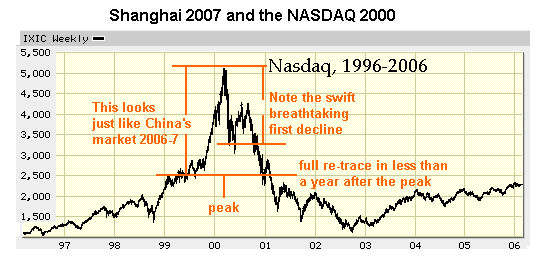
Frequent contributor U. Doran sent in two links describing the unsustainability of the Shanghai stock market: China Crash - domino effect on US markets (great charts) Shanghai stock bubble compared to Nasdaq bubble (stunning charts) Longtime correspondent Albert T. sent in this link describing the cooling real estate market in Shanghai: Shanghai eases land restrictions for foreigners: Concerned about a slowdown of contracted foreign investment, the Shanghai municipal government has eased restrictions to lure foreigners to invest in property development again, in a reversal of an earlier policy aimed at cooling down the real-estate sector.Albert summarizes the situation thusly: This is an interesting development. I smell a bubble bursting, and they need the final sucker to bail out the speculators (everyone).When everyone is a speculator playing with borrowed money, it's a mania/bubble, regardless of the nation or the era--and all mania/bubbles end the same way. If you need further evidence that the bubble in the Shanghai stock market is a mirror of the bubble in Shanghai real estate, consider this tidbit from Shanghai slump as China cools markets: An indicator of the widespread speculation gripping the Shanghai exchange came last month with a Chinese government website reporting that one in 10 maids in the city, China's financial capital, had quit their jobs to take up trading full time.When maids are quitting to play the stock market and local governments are relying on flipping stolen land to speculators, the mania/bubble is clearly about to burst. Maybe afterward, when people have lost their fortunes and their anger knows no bounds, then a more sustainable model of development will arise. Thank you Riley T. ($30.00) for your second generous and very unexpected donation. I am greatly honored by your ongoing support (and dystopian wit). All contributors are listed below in acknowledgement of my gratitude. If you found value here, perhaps you'd like to Your readership is greatly appreciated with or without a donation. Why Interest Rates Will Have to Rise May 30, 2007 This may be one of the most important entries of the year. I admit, it's not truly earth-shattering like the news of which airhead starlet has been arrested this week for a DUI on the Pacific Coast Highway, but since it's about money on a global scale, it might be of some interest (pun intended). Let's go through the standard reasoning about interest rates. One school of thought believes that the bursting of the global debt bubble will lead to deflation, and this will cause the Federal Reserve to lower interest rates in order to keep the bubble (borrow and spend) economy pumped up. The other school of thought foresees inflation or even hyper-inflation as the inevitable result of a hyper-inflationary monentary policy (easy lending, low rates, endless funds available for lending). To save what's left of the dollar, the Fed will eventually have to raise interest rates. What if both scenarios are missing the point? What if interest rates will have to rise regardless of inflation or deflation or the slowing economy? Let's start with a chart, courtesy of www.brillig.com (the debt clock). This is an inflation-adjusted depiction of the U.S. National Debt--the debt which has accumulated from years of massive deficit spending and borrowing from foreign entities. (The comments in black are mine.) 
Do you notice the tiny little difference between the previous Bull Market era of prosperity (1946-1966) and the current era of "prosperity"? Hmm, this is a tough one. . . could it be those decades of massive, explosive deficits? What kind of "prosperity" requires borrowing trillions of dollars to sustain it? Can it even be called "prosperity" if a significant driver was borrowed money? Even during the "non-prosperous" Bear Market era of stagflation in the 70s, the nation didn't borrow much more than it had during boom times (adjusted for inflation, which rose in the late 70s and early 80s). For a comparison of that era and our own, let's turn to correspondent Mark P.'s recent observations: (emphasis added) I was reading this article on rising gasoline prices and started to think about the past, particularly the late 70s when I was a kid.Mark's commentary led me to this conclusion: the debt is already so large, the Treasury will soon have no choice but to raise long-term interest rates. To see why, let's look at another chart: 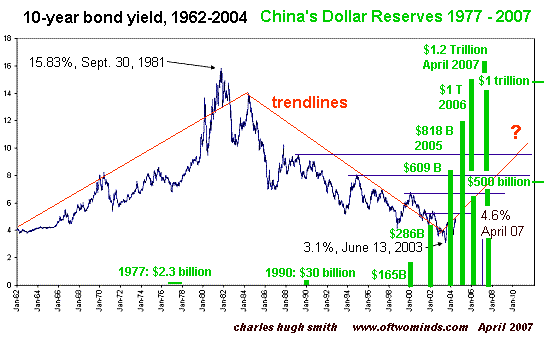
Notice how the Chinese central bank has ramped up its purchase of U.S. Treasuries to what is clearly an unsustainable rate. Before we go on, let's recall a few key points: The cliche repeated in the mainstream media is that China continues buying hundreds of billions of U.S. bonds every year as a "safe" investment." How "safe" is an investment which has lost 1/3 of its value in the past 5 years? (The dollar Index has fallen from 120 in 2002 to 82.) We all know the real reason China has been pouring the vast majority of its foreign reserves into Treasuries--to support low interest rates and therefore the purchasing power of the dauntless "borrow and spend" American consumer. The larger question is: how sustainable is a debt machine dependent on the fortunes and good will of one's trading partners? What could cause the Chinese to cease new purchases or to even start selling Treasuries from their horde of $1.3 trillion? (It's rising by about $125 billion a quarter.) Once the Chinese either decide to stop supporting the U.S. debt machine, or find they no longer can do so regardless of their desire, the market for low-interest rate Treasuries dries up. Yes, the Gulf states are big buyers, too, but there is no evidence they can double or triple their bond purchases to cover what China currently buys. How vulnerable are we? Very. One solution is to stop running deficits of $300 - $400 billion a year; that would be $400 billion less debt we need to find buyers for. But which of our elected officials would have to courage to cut $400 billion in spending? The real problem is the debt is already unsustainably large. Even if we as a nation stopped spending more than the government collects, the existing debt constantly rolls over and has to be refinanced. If money dries up globally, we are in a real pickle. With a negative savings rate, does anyone seriously believe we can fund our own deficit? And here's one more "follow the money" line of thought. Who gets hurt if the Treasury refuses to support the plummeting bond/dollar by raising interest rates? Joe Sixpack? Not really. How much does Joe Sixpack buy that is made in Europe or Japan? The Japanese nameplate vehicle he buys is actually made in the U.S.; only the profit is repatriated to the home country. If he travels outside the U.S., then the weak dollar will hurt his purchasing power--but how often does Joe Sixpack go to Europe or Japan? (Recall that the Chinese yuan is pegged to the dollar and does not fluctuate much even as the dollar tanks.) As for food--it's mostly priced in dollars. Ditto oil/energy, so a plummeting dollar will have little effect on Joe's purchase of these commodities (unless OPEC starts pricing oil in euros. Then it's Katie Bar the Door.) No, the big losers in a bond/dollar collapse are the wealthy. As documented here many times (via links to the Wall Street Journal), the top 5% of U.S. citizens own about 2/3 of all the stocks, bonds and real estate in the country. If the bond and/or dollar drops through the floor, their holdings will be worth a lot less globally--and the wealthy of the world are global players. So ask yourself: if our patsy trading partners are no longer willing or able to gamble all their surpluses on the dollar and Treasuries, or we have finally worn out our welcome in China and the Gulf so that politicians/bankers in those regions decide to stop supporting low interest rates in the U.S., then will our politicians really care about Joe Sixpack losing his bubble-priced home? The short answer is no. They will care about the wealthy, who fund their campaigns. Joe Sixpack doesn't even bother to vote (U.S. voter turnout is barely 40%; in the recent French election, turnout was 85%.) Yes, there will be tearful speeches and a lot of hot air expended about poor Joe, but when push comes to shove, the Treasuries have to be sold--there is no Plan B--and the wealthy's holdings in dollars will have to be defended. Joe Sixpack? Sorry pal, suck it up; you blew it signing that adjustable rate mortgage and paying bubblicious prices and tapping all your equity with a home equity line of credit. Too bad you believed all that mainstream media shuck and jive about interest rates staying low forever. Thank you Abrey M. ($25.00) for your generous and quite unexpected donation. I am greatly honored by your support. All contributors are listed below in acknowledgement of my gratitude. If you found value here, perhaps you'd like to Your readership is greatly appreciated with or without a donation. What to do about Health Care? May 29, 2007 Here is the one essay you need to read this year about healthcare in the U.S. It will change your perspective, for it offers contexts and solutions I've read nowhere else. I asked frequent contributor Michael Goodfellow to write down the many healthcare-related ideas we've shared via email, and he's written this perceptive, thought-provoking essay: What to do about Health Care? Here is the first paragraph: Charles asked me to write something about the health care system in the U.S., but before I do that, I should add a few words about my own situation. The opinions below could be read as a rant by some overpaid techie who has never been sick a day in his life. Sadly, that is not the case. I sustained a spinal chord injury at age 7, and have spent the rest of my life in a wheelchair. Long-term paralysis leads to other complications, and so I now have multiple serious conditions. I have seen more than my share of the health care system.For another "real world" window on our healthcare system, please read yesterday's entry, "The Test of a Nation." After pondering this critically important issue, you might enjoy an amusing serving of witty parody, Memo to the next UK Prime Minister by Protagoras. The Test of a Nation May 28, 2007 A Memorial Day thought: The test of a nation's commitment to its Armed Forces veterans is two-fold: how they are treated during a war, and how they are treated five, ten and twenty years later. With some 60% of Iraq War veterans experiencing some form of PTSD (post-traumatic stress disorder), I have to wonder if we as a nation will abandon the vets as soon as the war winds down, as occured after Vietnam. I hired many Vietnam vets when I was a builder in the early 1980s, not because they were vets (I didn't ask) but because they were looking for work. A number had psychological problems relating to their service in Vietnam; these problems included extreme withdrawal, outbursts of rage, and inability to concentrate. Others were drifting through their 30s, camping at the beach, while one set of brothers took their Mom with them wherever they found work. I rented a camper on the jobsite for their Mom and paid her a small sum to keep an eye on things. (She was one tough cookie; by her own choice she was armed, as she knew how to handle firearms.) Would the guys have been troubled even if they hadn't served "a one-year hike through the jungle" (one's apt description of his 'Nam duty as an infantryman)? Perhaps. Would the Veterans Administration facility on Oahu (Honolulu) provided sustained treatment for them? Perhaps. Did they even consider going in for treatment? Perhaps not. What I do know is that we as a nation shunned these vets, underfunded the VA system, and generally ignored PTSD or "blamed the victim" (aw, those guys are just whiners, etc.). I fear that once hostilities in Iraq wind down (for whatever reasons), the nation will quickly avert its eyes from the individuals who paid the price internally for their service and rush to cut the VA (and military readiness) budgets as the recession bites deeply into tax revenues. I hope we won't repeat the tragic cycle of postwar denial and abandonment suffered by many Vietnam-era vets, but I am not confident that our nation will choose to spend money to support our vets long after the war is over. I fear the powerful constituencies protecting entitlements (Medicare, etc.) and pork projects will raid the VA budget to protect their own turf. For you see, vets are not politically powerful; those who are suffering often do so privately. And you can be sure the puffed-up pundits who have glorified the war will be the first to forget the vets who actually served. Continuing on the theme of responsibility: Knowledgeable correspondent Nurse Dorothy offers an "in the trenches" reaction to the May 24 entry on health and healthcare. I believe her comments are extremely important, and speak to issues which are virtually ignored in the mainstream media and the halls of Congress. Here is the chart she refers to: 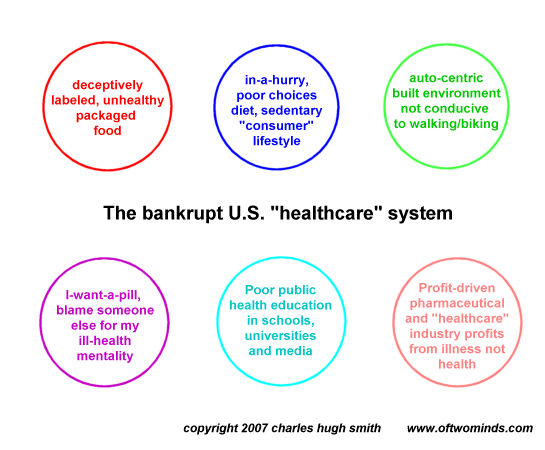
This is in regards to March 24th Health and Bankruptcy article. I know it's a little late in responding, but I just came off of a four day stretch at work. In that article there is a purple circle which says "I want a pill, blame someone else for my ill health". That statement screamed at me because it's so true. I have the perfect example.Thank you, Nurse Dorothy, for "plain speaking" to an issue we as a nation refuse to address: personal responsibility. Those of us who know working physicians and/or administrators in the "healthcare delivery systems" (i.e. hospitals and providers) know the medical malpractise system is utterly broken. Yet at the same time, I wonder if a class-action lawsuit might not be the only weapon vets will have to channel funding to the VA when its budget is slashed to protect more politically powerful government-funded fiefdoms. Responsibility is two-fold: as a nation, we are responsible for the care of those who served, especially those who served in combat. We must keep in mind two things: service is voluntary, and the orders to go to war come from our civilian, elected government, not the Pentagon or senior military officers. Therefore we as a people sent them to war, and we are duty-bound to take care of them, regardless of the war's outcome. As individuals, we are responsible for our own health. It will come down to this, readers: we can either fund our VA hospital system, or we can pay for irresponsible civilians like Nurse Dorothy's trigger-finger-on-a-lawsuit patient. There won't be enough money for both, and we as a nation will have to choose who gets our support. My vote will always be for full VA funding, above all else--even my own Medicare benefits, should there be any left when I qualify. Today, and every day, my thoughts are of our friends who are serving in Iraq. Words fail me; just look at this photo. 
Thank you Michael S. ($25.00) for responding to my Memorial Day offer of a signed copy of my novel I-State Lines. I am greatly honored by your support. All contributors are listed below in acknowledgement of my gratitude. To view previous entries in May, go to weblog May 2007. (insert brilliant marketing line here which instantly causes erudite readers to) Your readership is greatly appreciated with or without a donation. Heroes and Heroines of New Media Financial contributors who have made multiple donations to this modest site. Thank you for your ongoing support and encouragement.
Our Financial Contributors Thank you all for your gracious and generous support of this modest site.
I would be honored if you link any essay to your website, print a copy for your own use or add my RSS or Atom feed. And of course I appreciate your recommendations of this weblog and your comments: csmith@oftwominds.com. wEssay noun, combination of 'web' and 'essay,' denoting a short online essay which exploits the hyperlinks, interfaces and interactive capabilities of the World Wide Web; coined by Charles Hugh Smith on May 1, 2005, in Berkeley California. Aphorisms I like: "Economic history is a never-ending series of episodes based on falsehoods and lies, not truths. It represents the path to big money. The object is to recognize the trend whose premise is false, ride that trend, and step off before it is discredited." (George Soros) "The way of the Tao is reversal." (Lao Tzu) "Chance favours the prepared mind.” (Louis Pasteur) "It is neither necessary to hope to undertake, nor to succeed to persevere." (French proverb) "You must have a willingness to do something when everyone else is petrified. You must learn the lesson of following logic over emotion." (Warren Buffett) "Success consists of going from failure to failure without loss of enthusiasm." (Winston Churchill) "May a fair road always be open to you." (CHS, April 2, 2006) All content and images copyright © 2006 - 2007 Charles Hugh Smith, All rights reserved in all media, unless otherwise credited or noted. |
 |

This Week's commentaries
June 15, 2007 This Month's Journal Essays 06/09/07: Love in the Time of Syphilis by Protagoras 05/29/07: What to do about Health Care? by Michael Goodfellow 05/26/07: Memo to the next UK Prime Minister by Protagoras 05/21/07: Political Elites & Some Predictions by Michael Goodfellow 05/11/07: The Fort Dix Terror Plot by Harun I. The French Presidential Elections by John Kinsella Wal-Mart, disequilibria, and global economic dislocation by Harun I. The Recent UK Elections by Protagoras 05/05/07: The Evolution of Social Behaviour by Protagoras Is Everybody Happy? by Michael Goodfellow Memories of Lana'i by Bill Murath
Why I gratefully accept donations and why you might want to donate:
Worth Visiting: ilind.net Mish's Global Economic Trend Analysis Marin Real Estate Bubble West Coast of Canada- Housing/R.E. blog Westside Bubble (L.A.) New York City Housing Bubble Mortgage Lender Implode-o-Meter (Aaron Krowne) California Housing Forecast View from Silicon Valley Credit Flow Investor Rick's Picks Gold Eagle Econotech Great Depression 2006 SocietyDirectory.org Good Web Directory Satellite Sky Policy/Ideas L.A. Visions Darrell Clarke transpo, planning Authors/Artists John Francis Kinsella author/painter Sumpinein (blog) "Letter from Basque Country" Financial Armageddon Michael Panzner The Rhythm of War Terence Parker Bill Murath (chimes & art) buy my novel I-State Lines at The Kaleidoscope (indie bookstore, free shipping) Or from my publisher, The Permanent Press Or from amazon.com: I-State Lines If you want to own gold, I recommend: Buy gold online - quickly, safely and at low prices at BullionVault If you need a quick gift, I recommend: Amazon.com gift certificates Note: at no cost to you, I earn a small commission on purchases made via these two links.
search my site:
|
||||||||||||||||||||||||||||||||||||||||||||||||||||||||||||||||||||||||||||||||||||||||||||||||||||||||||||||||||||||||||||||
|
Our retail policy: Nothing is for sale except books/films I recommend and my own novel I-State Lines (via links to Amazon.com and The Kaleidoscope: Our Focus Is You independent bookstore) Free alternative: find them at your local library. Though I earn a small commission on Amazon.com books and gift certificates and gold (BullionVault) purchased via links on my site, I receive no fees for any links, advertising or materials on my site. |
home |